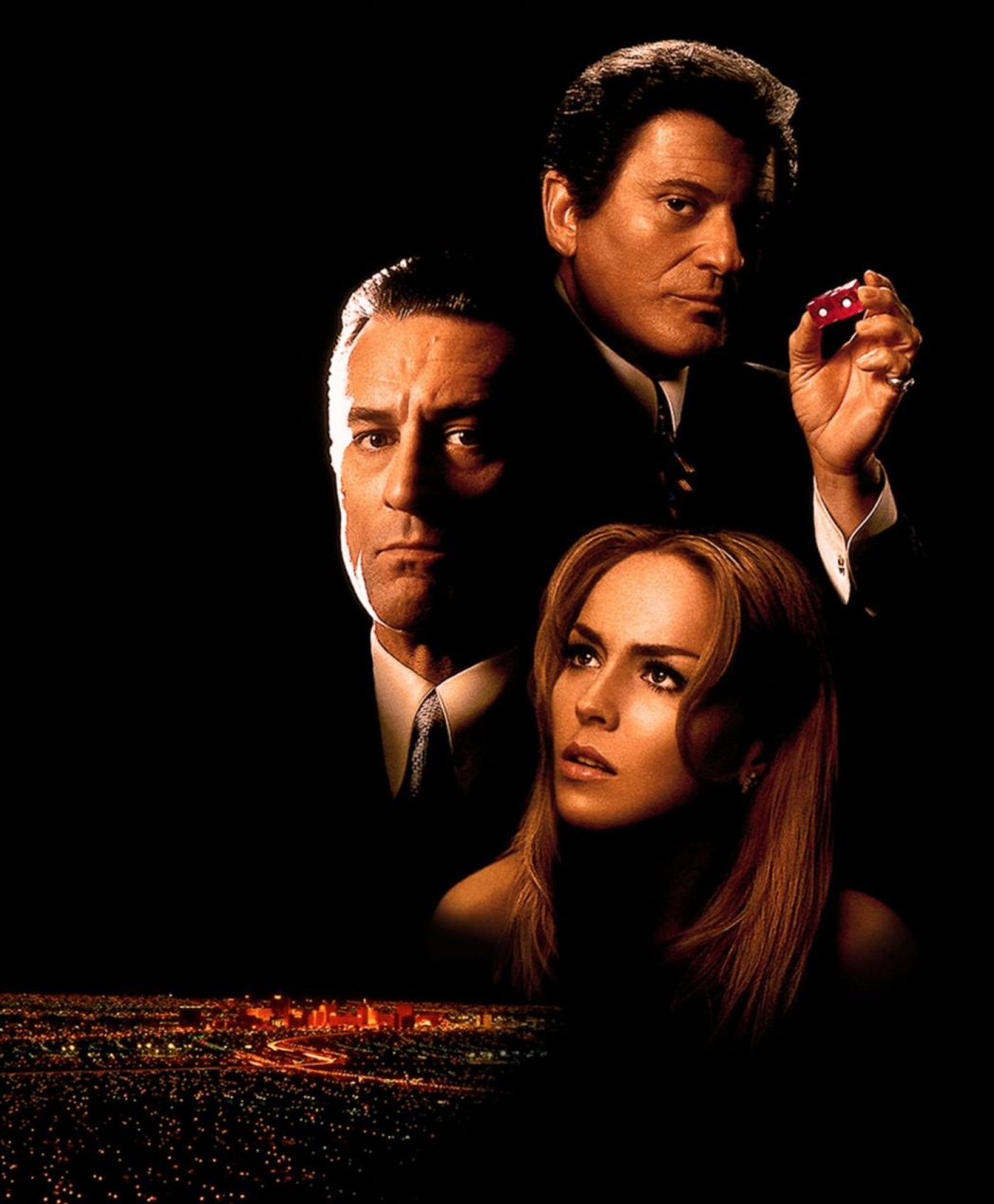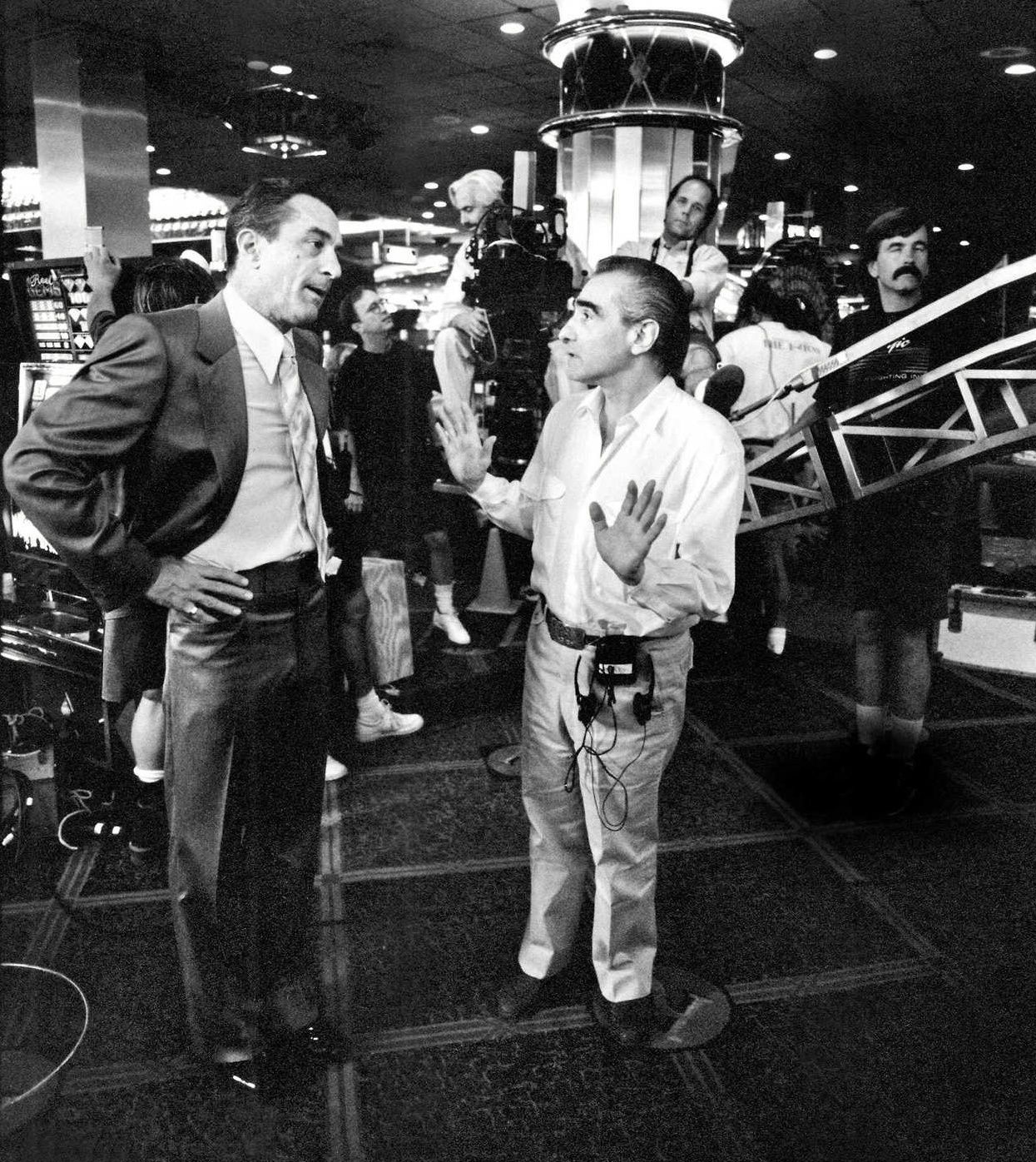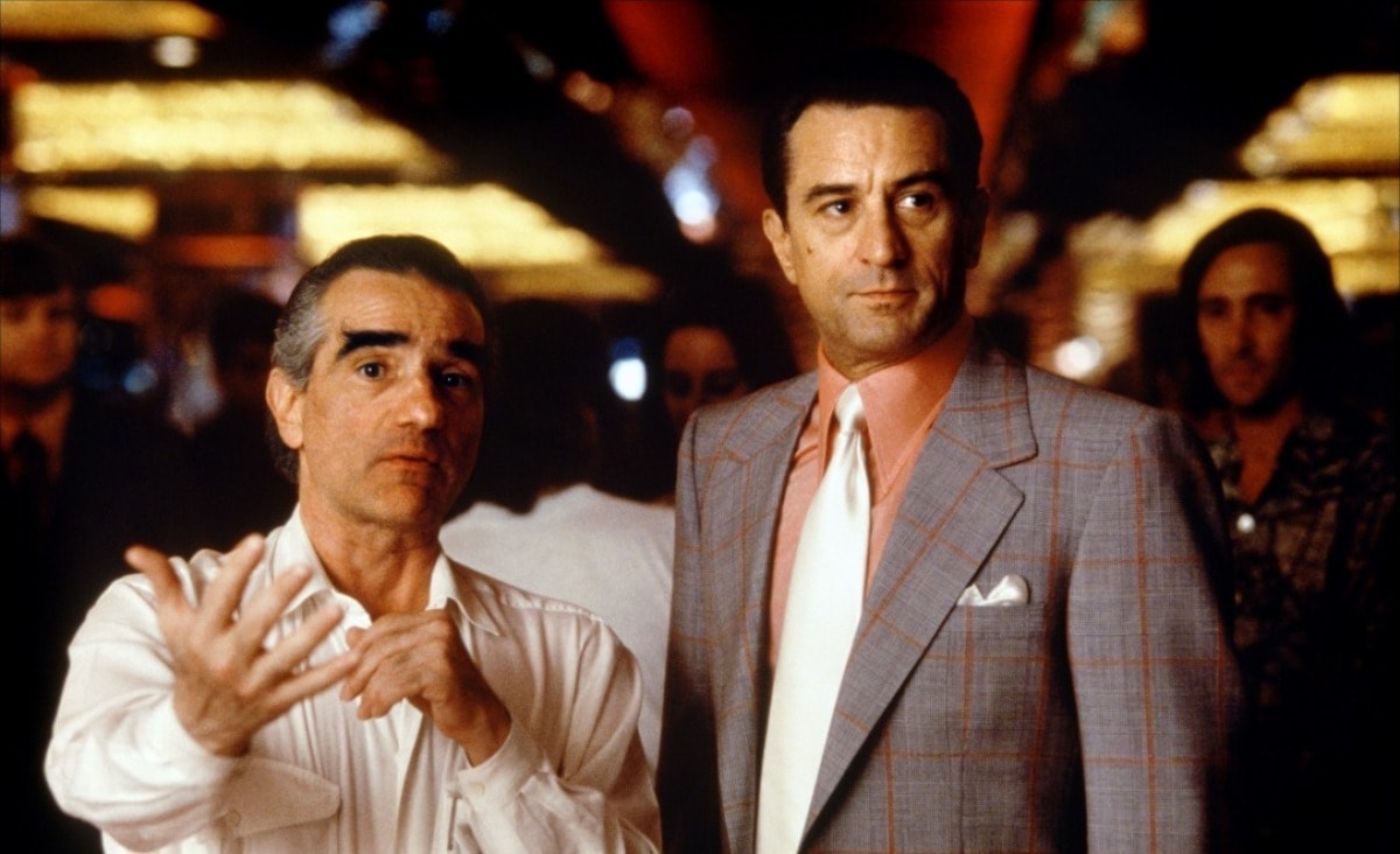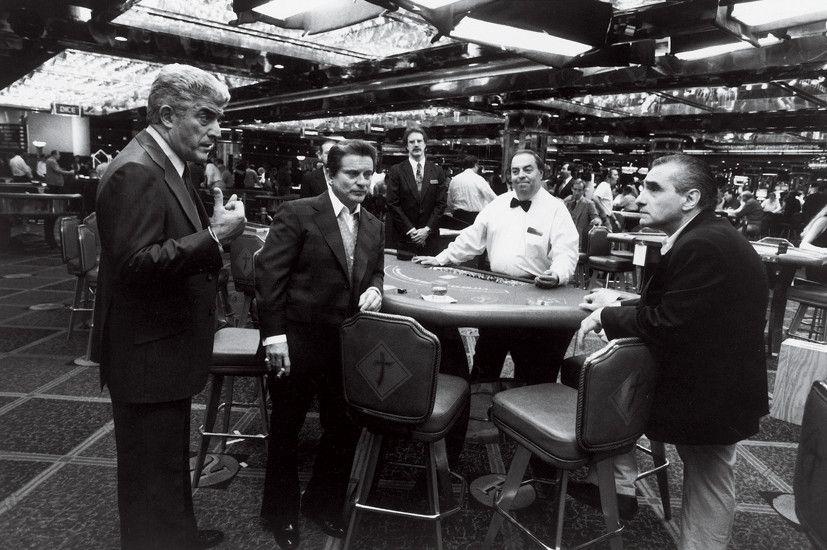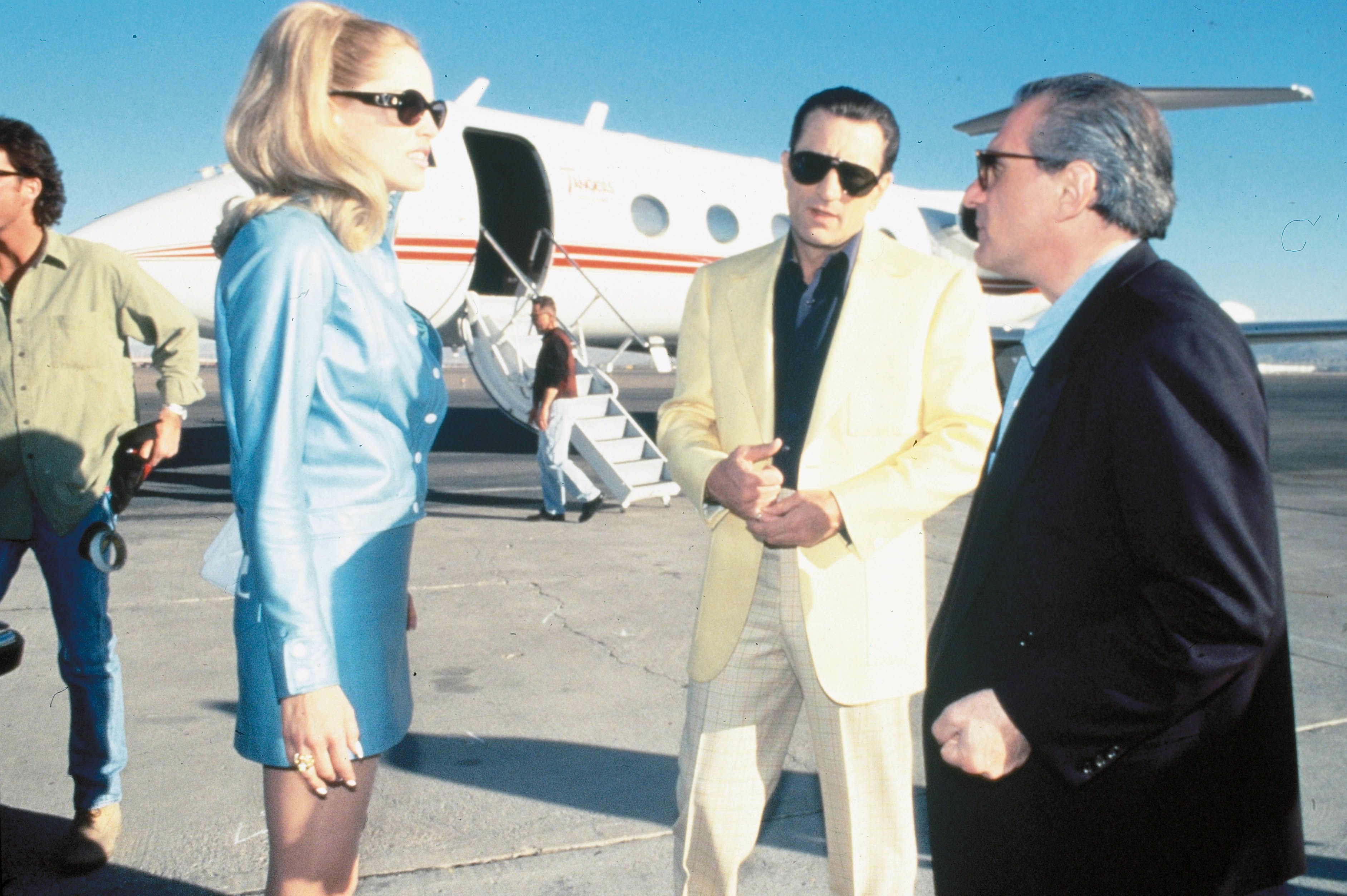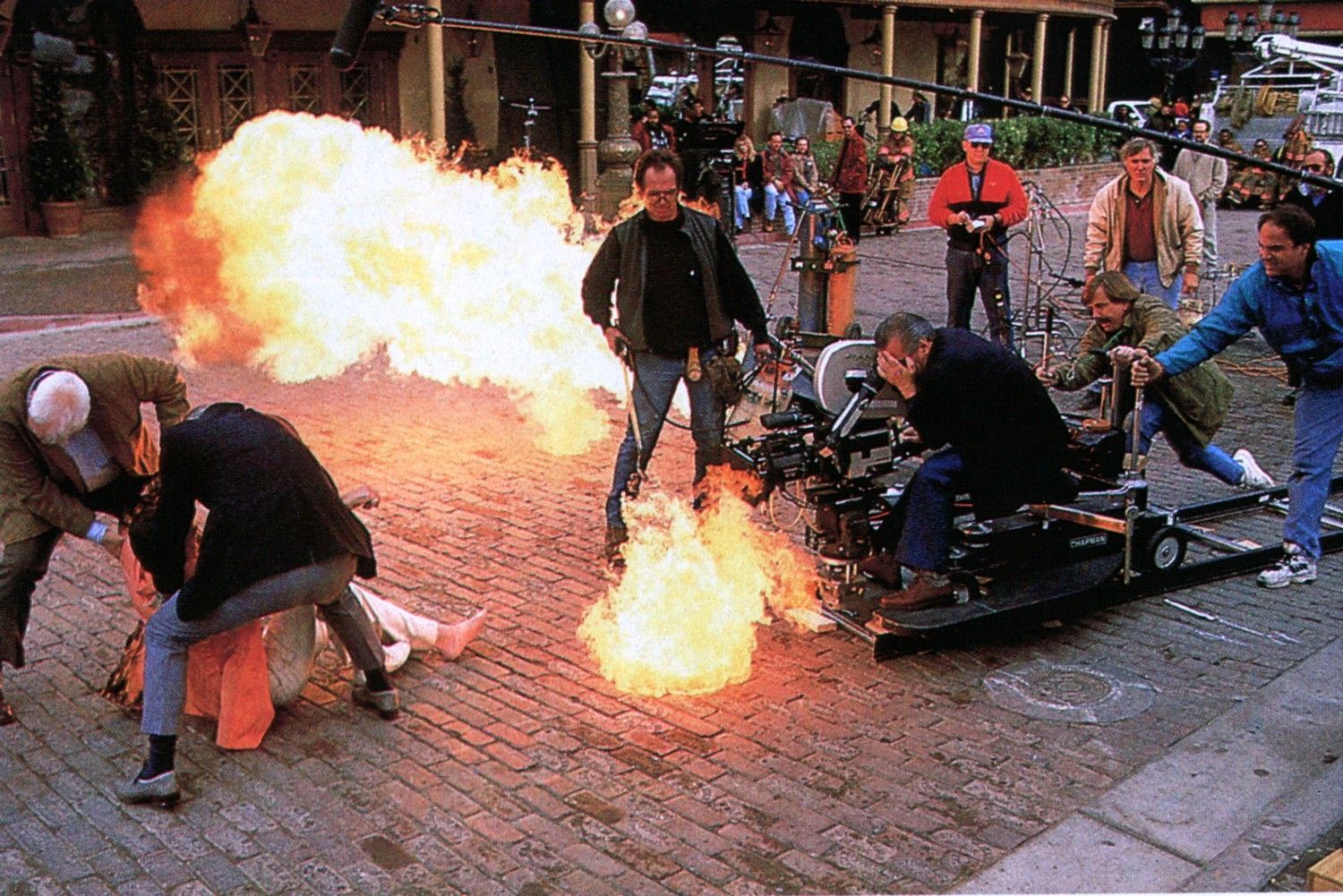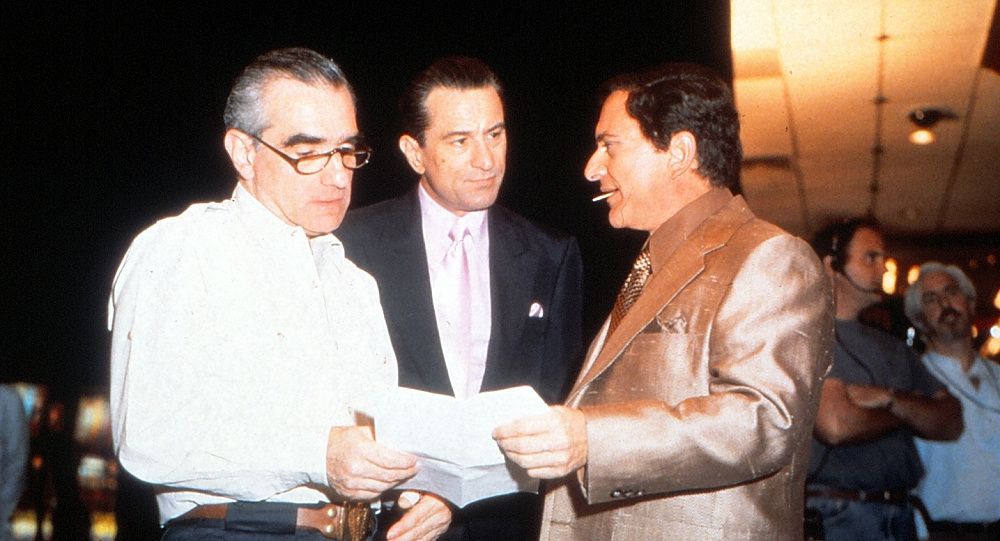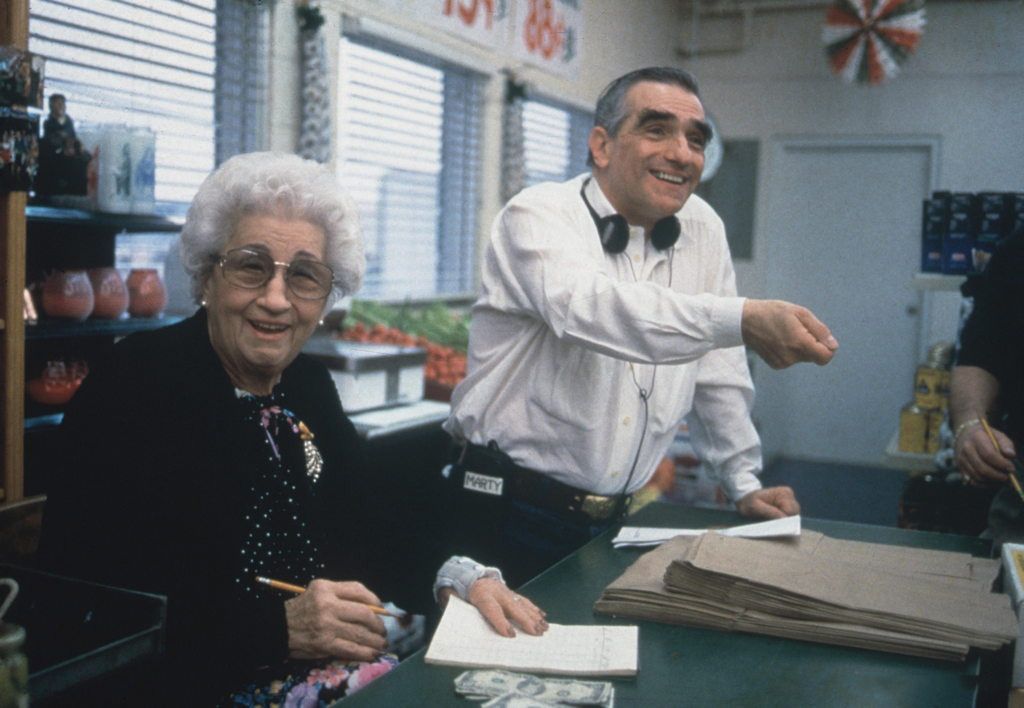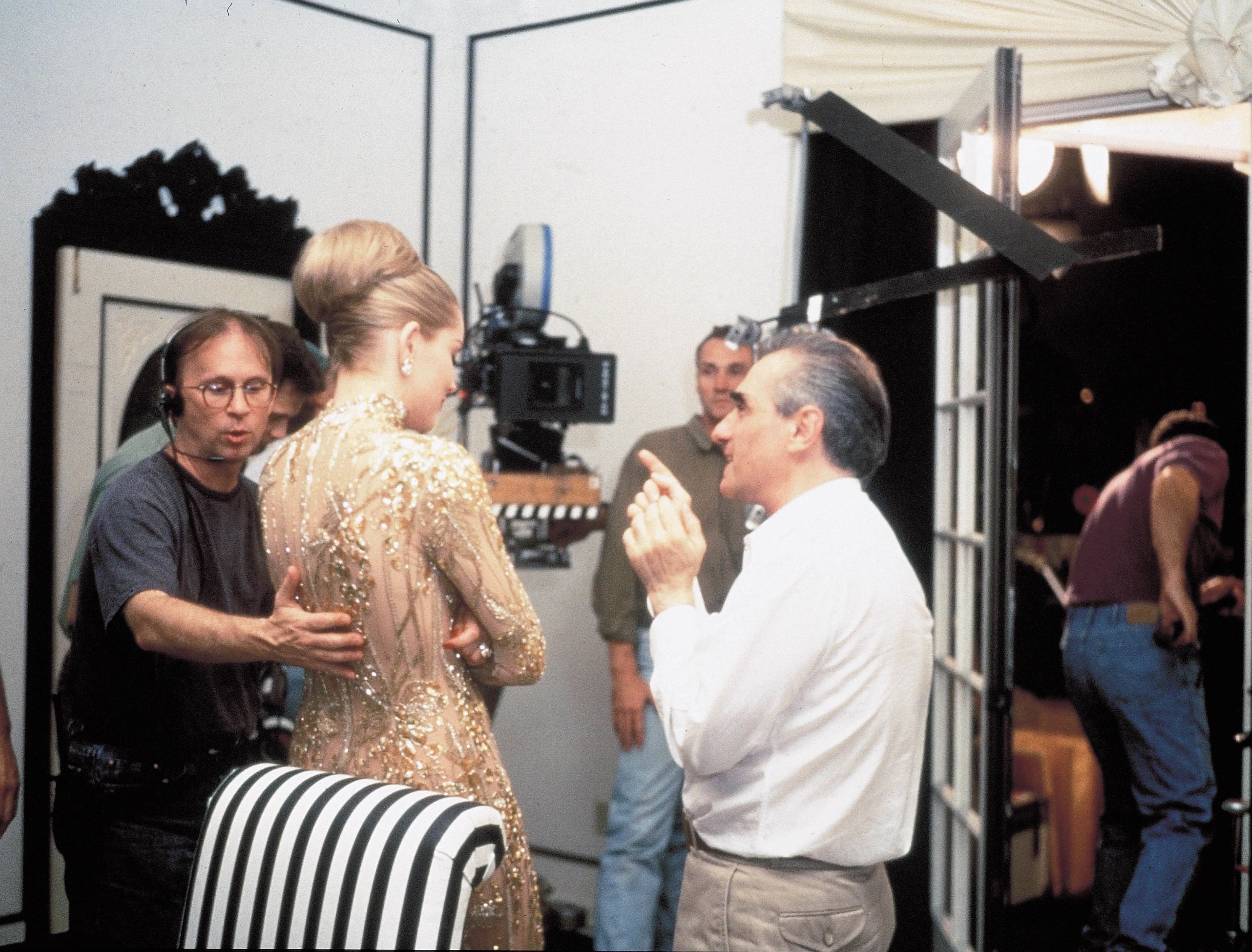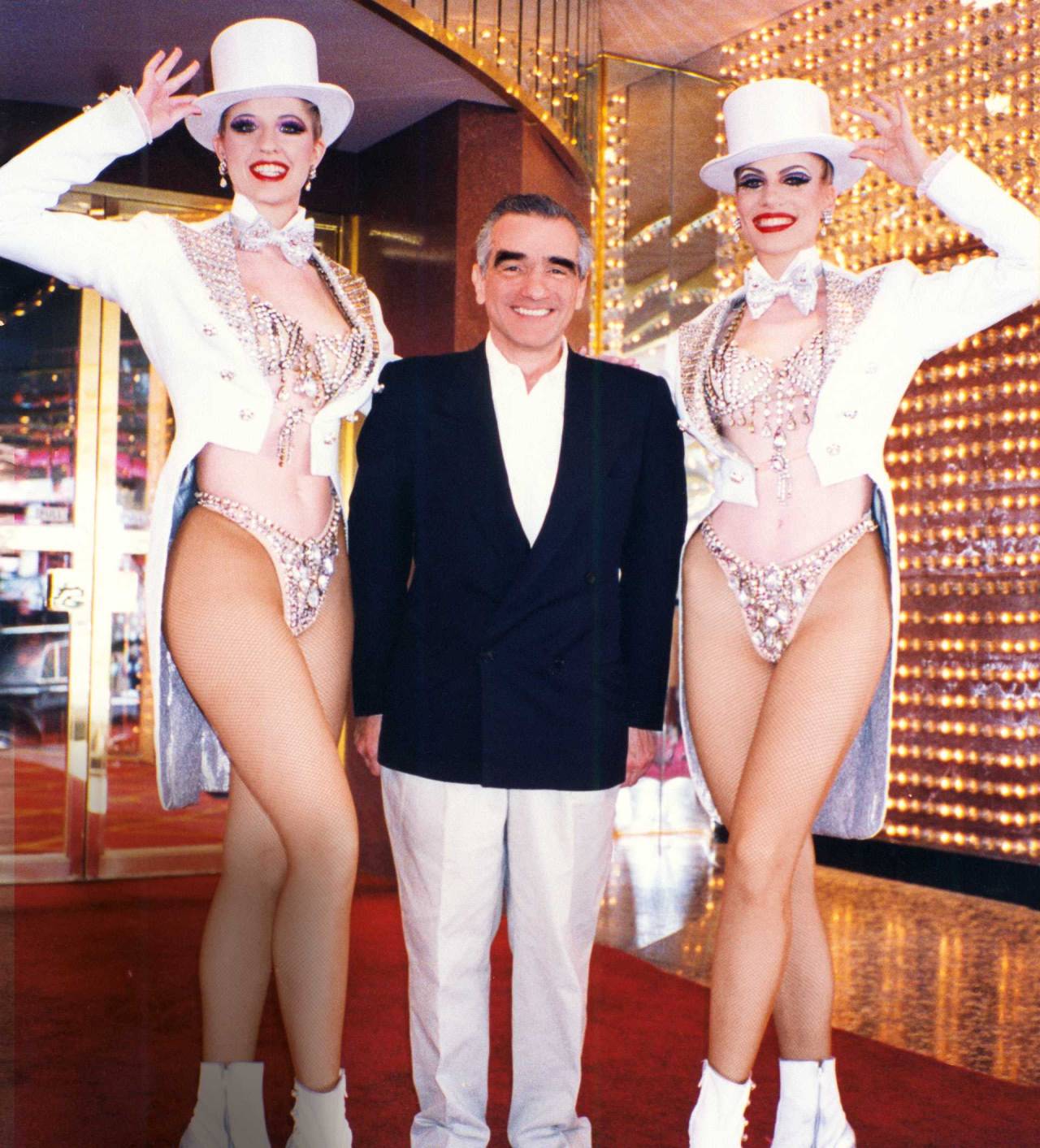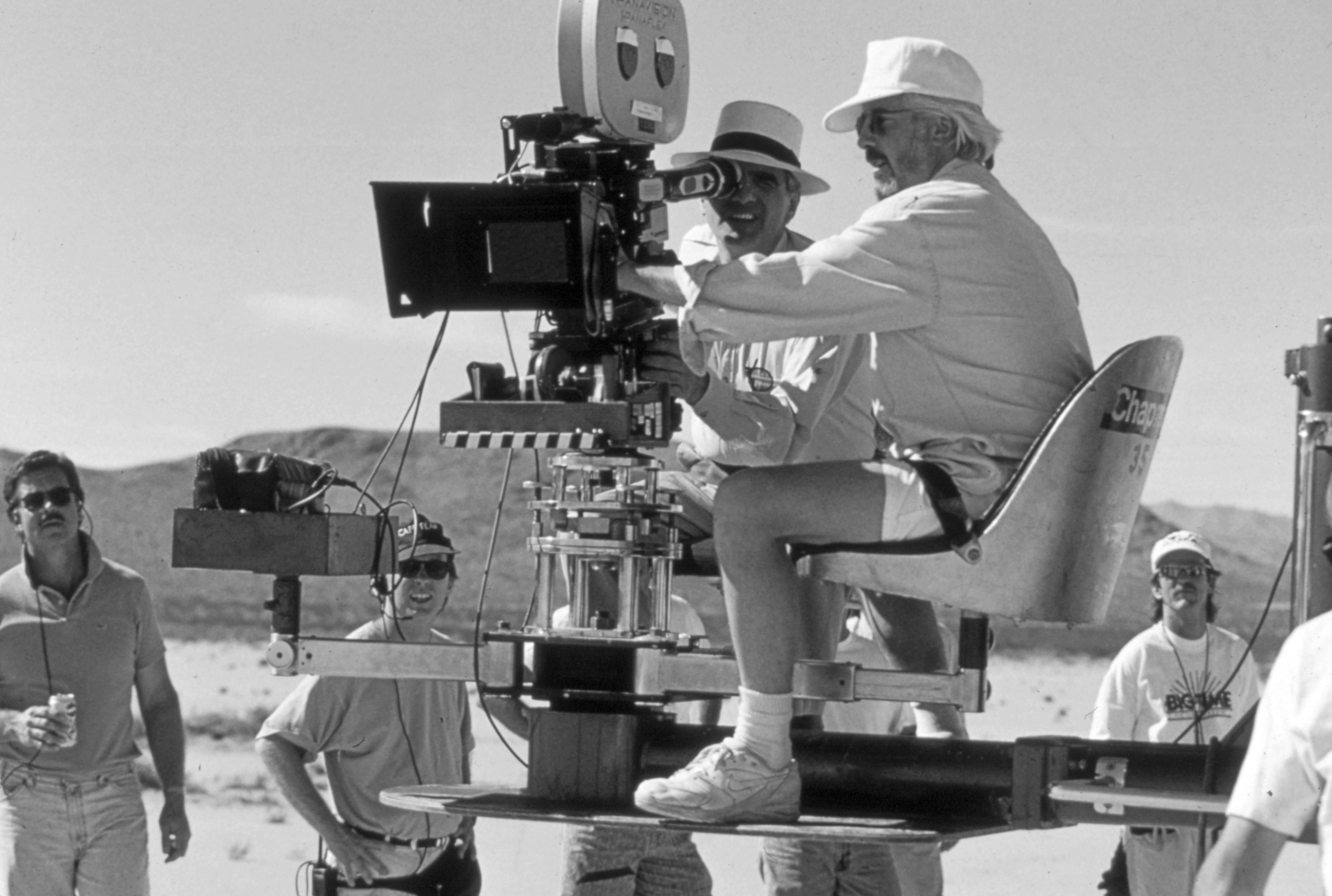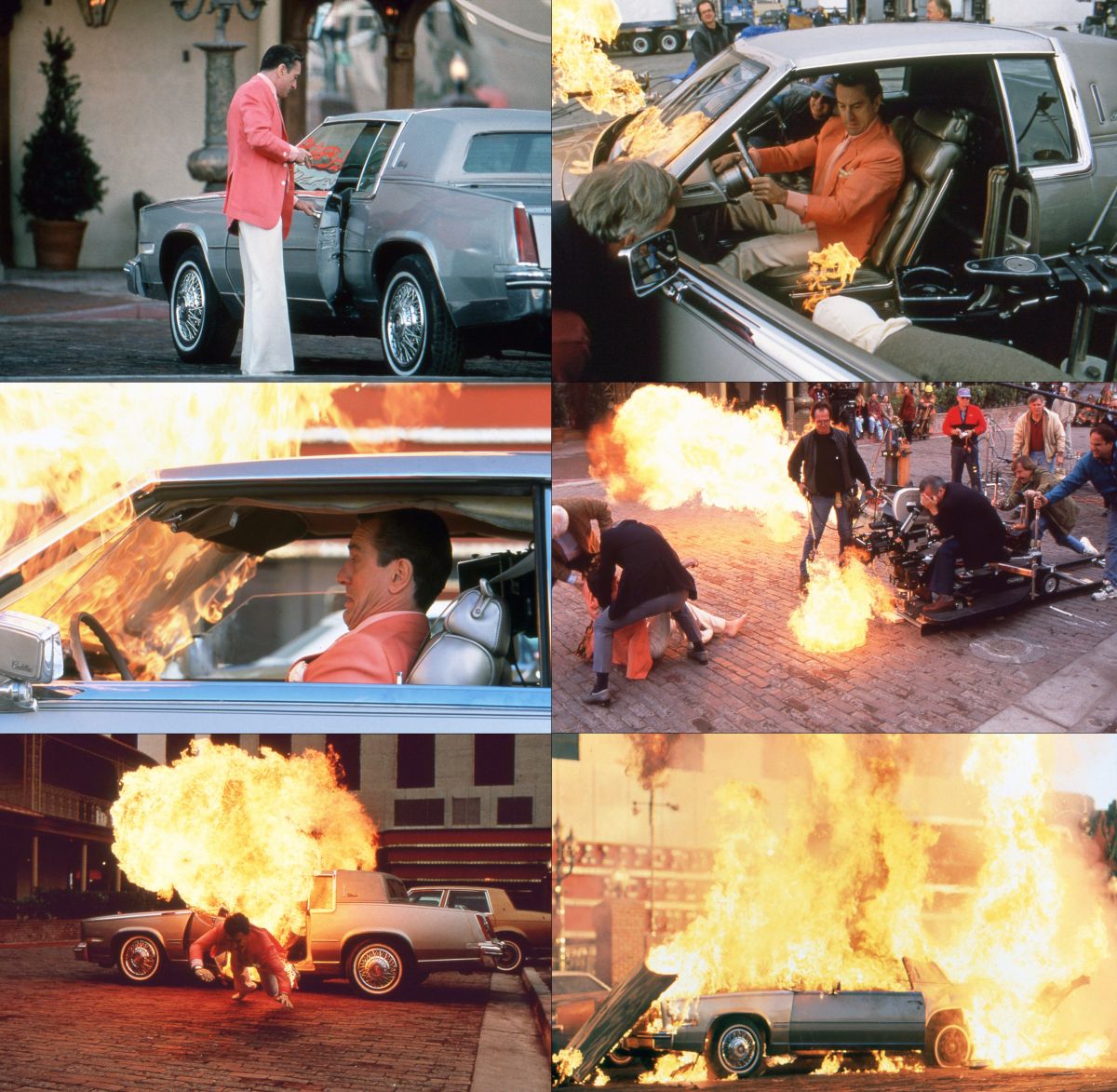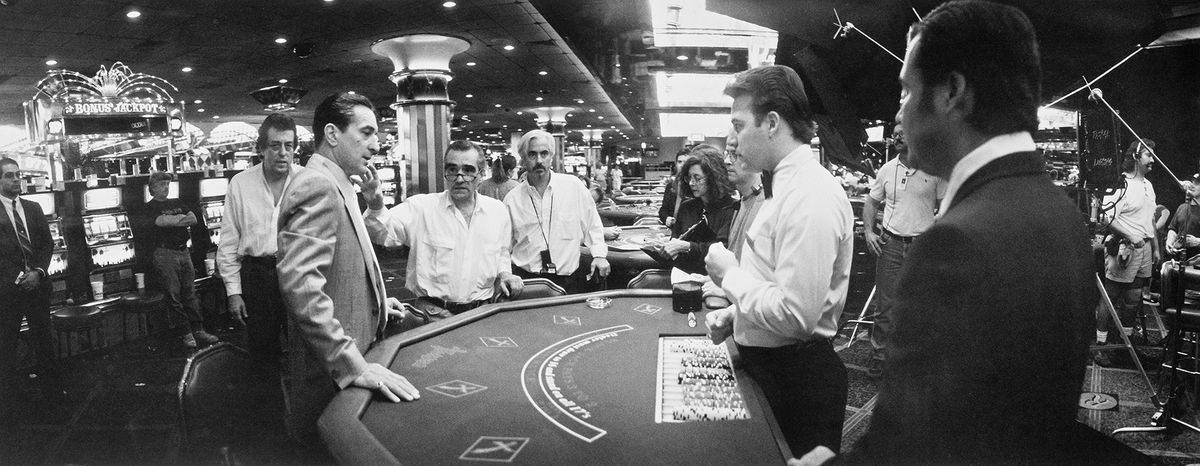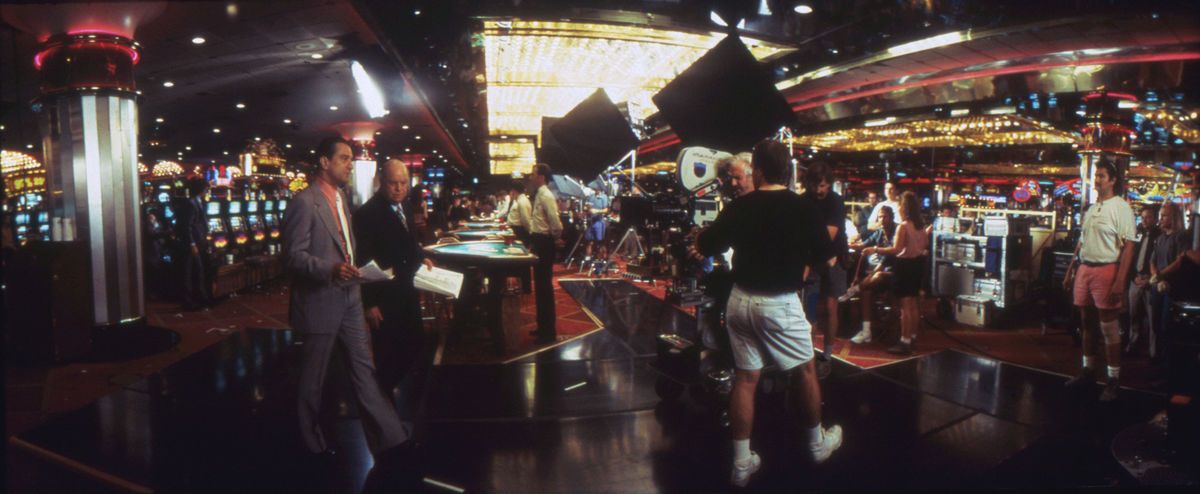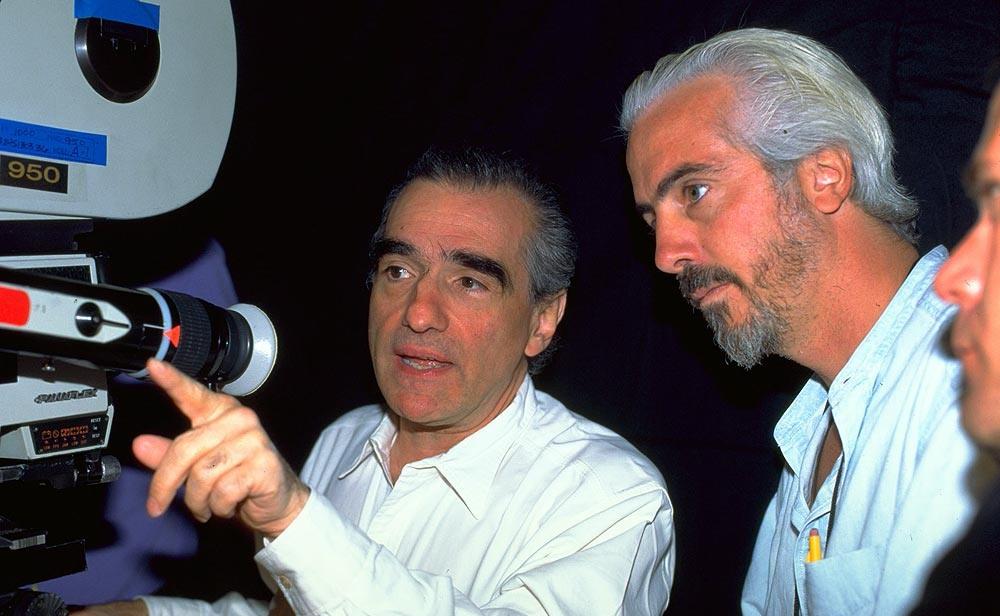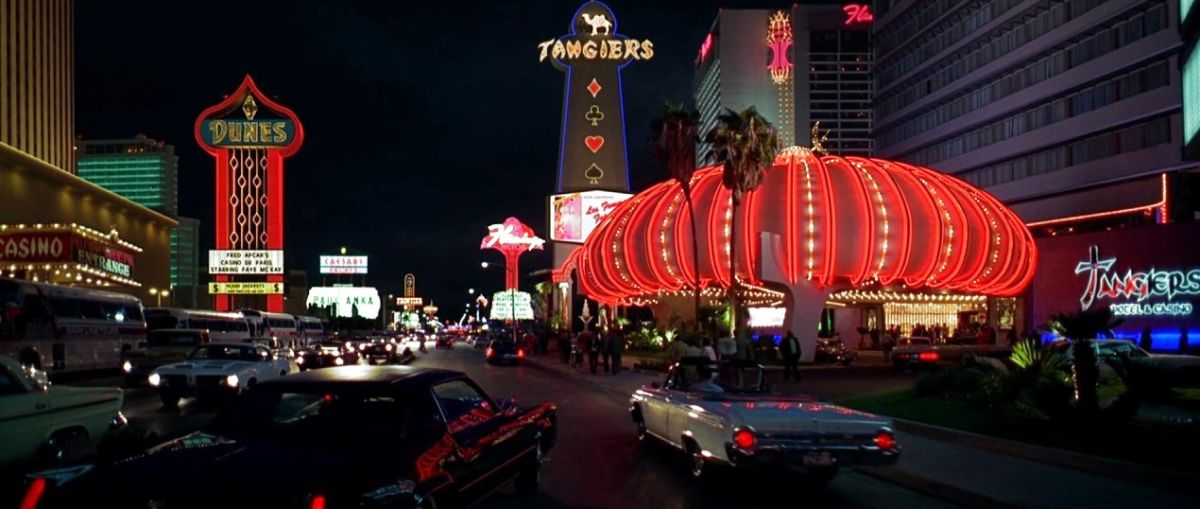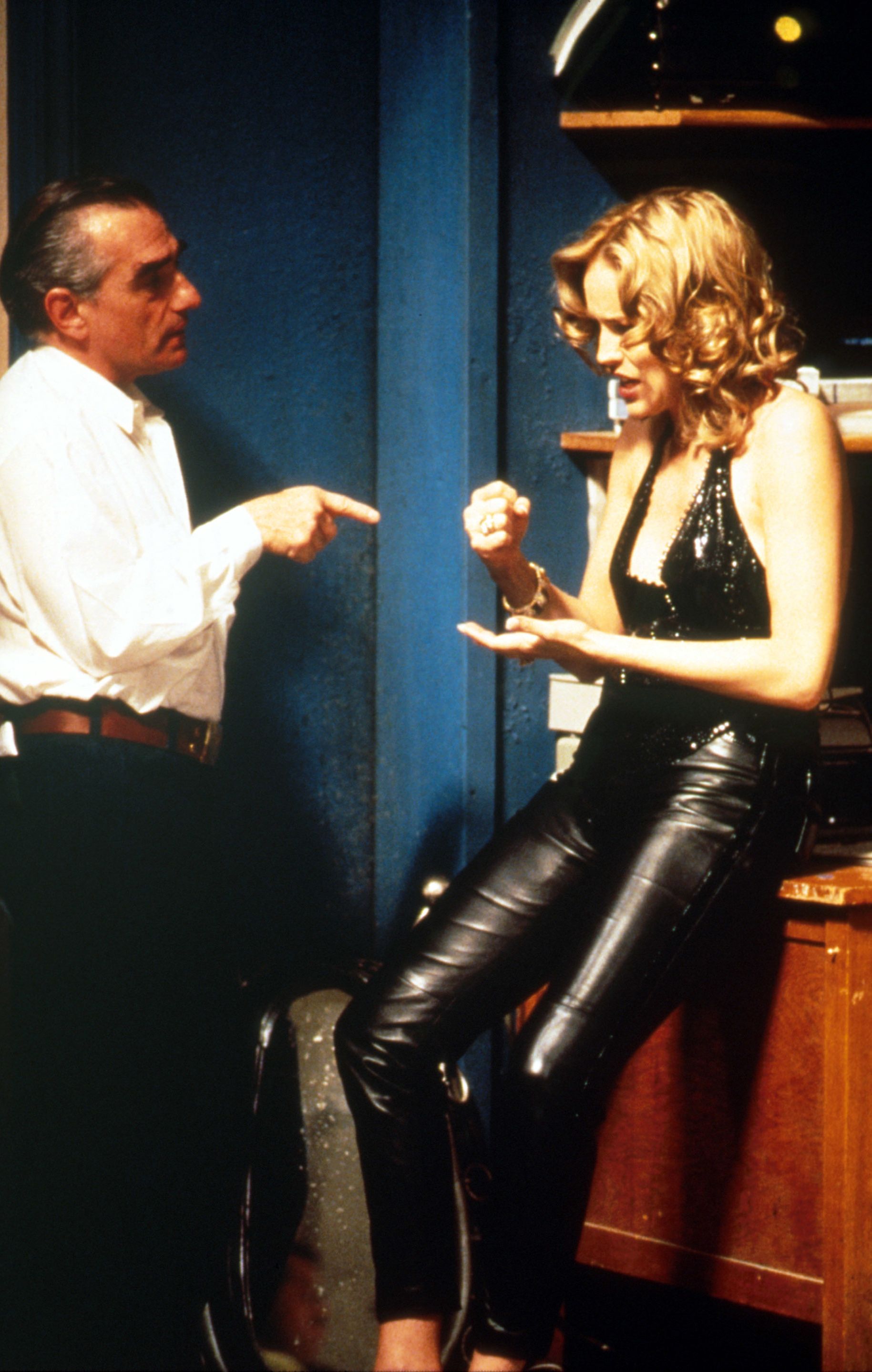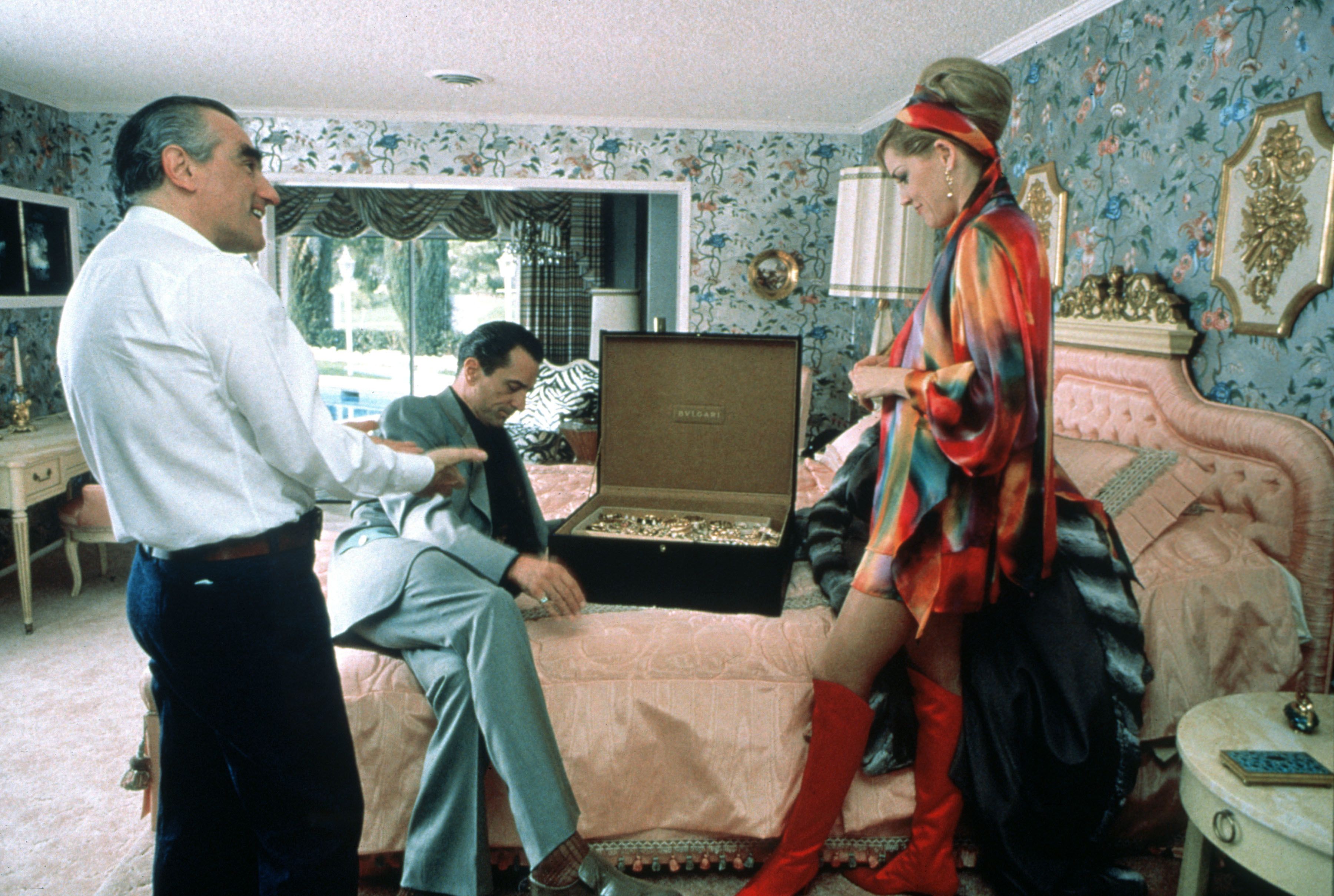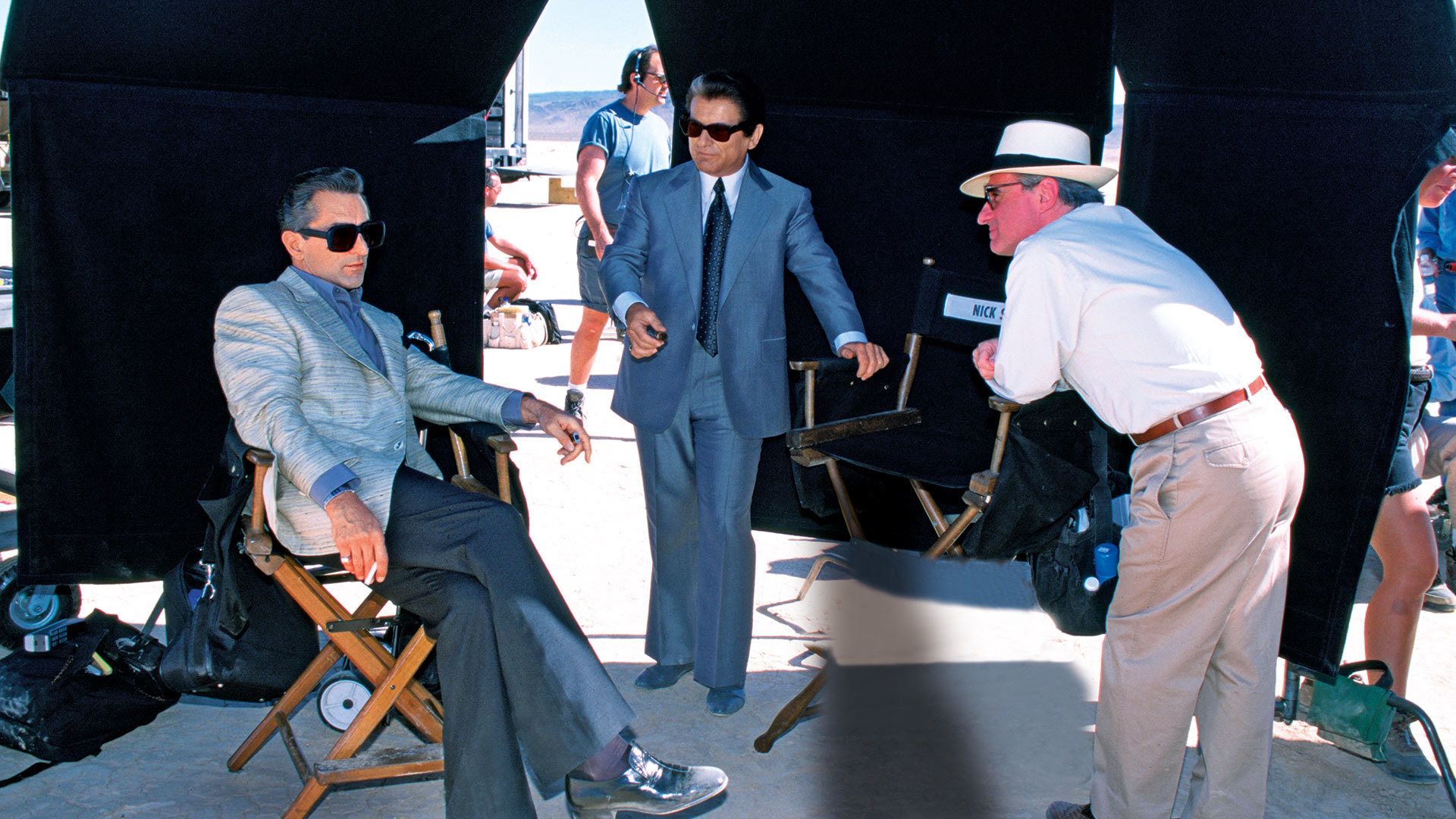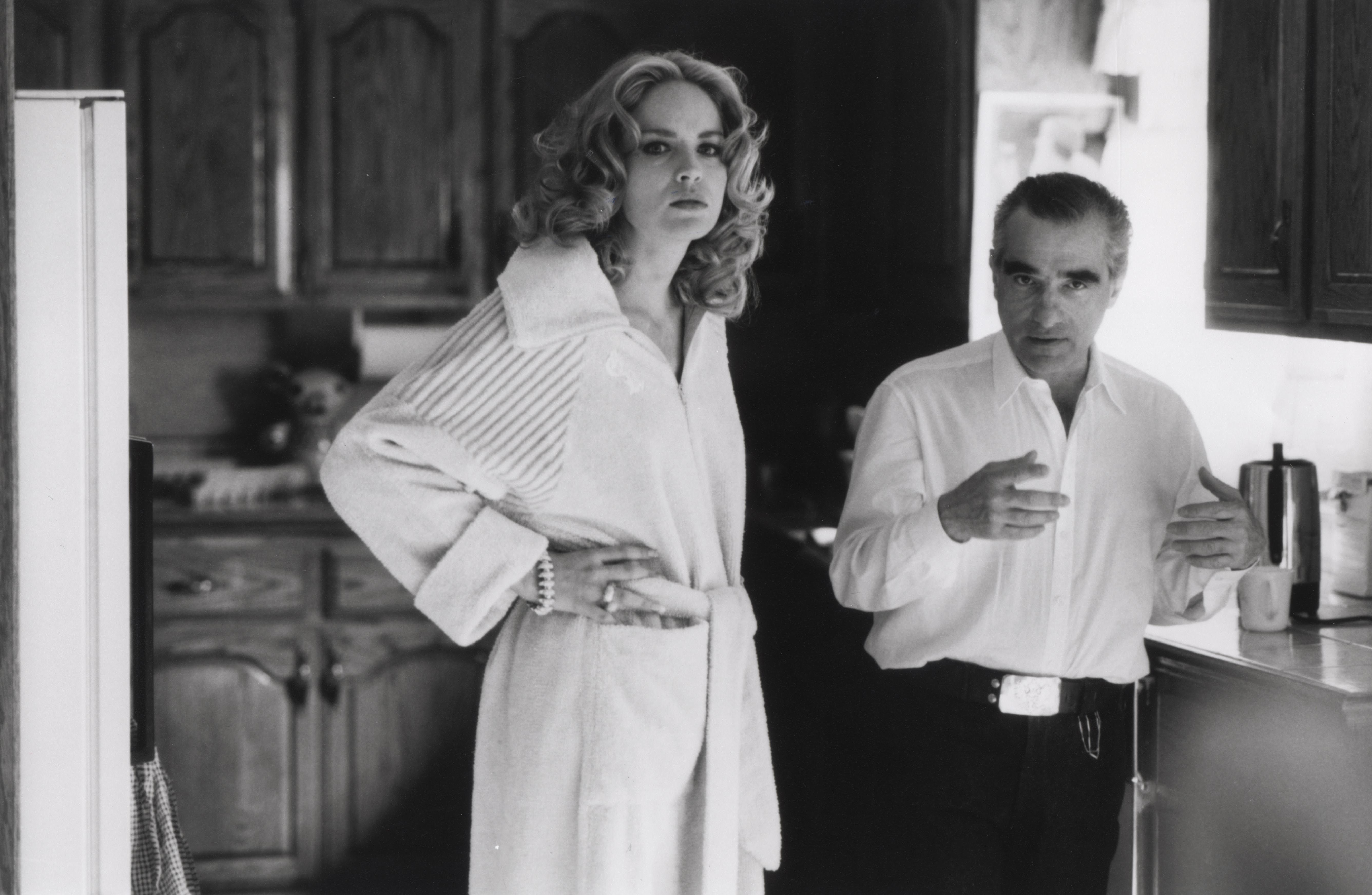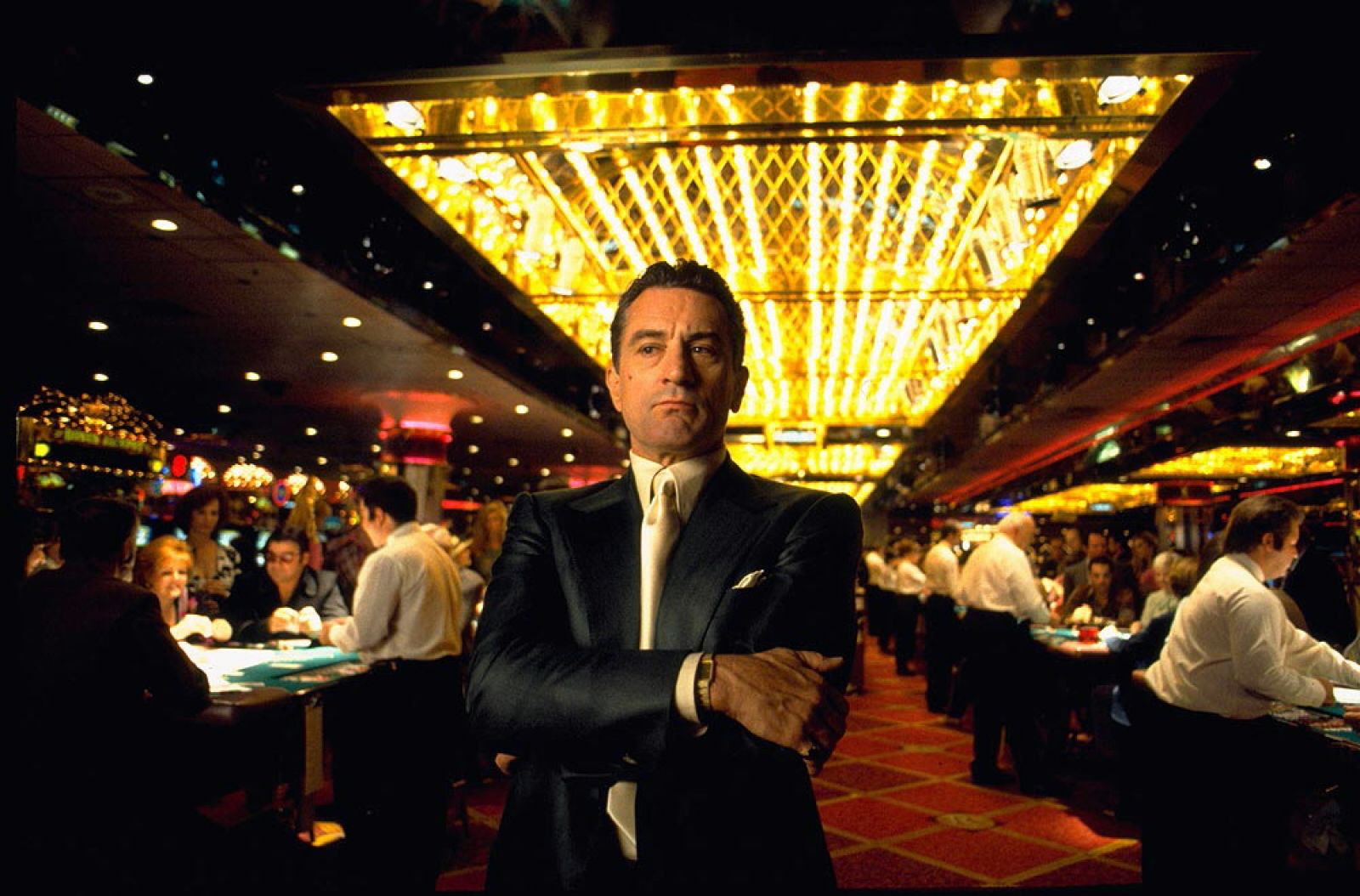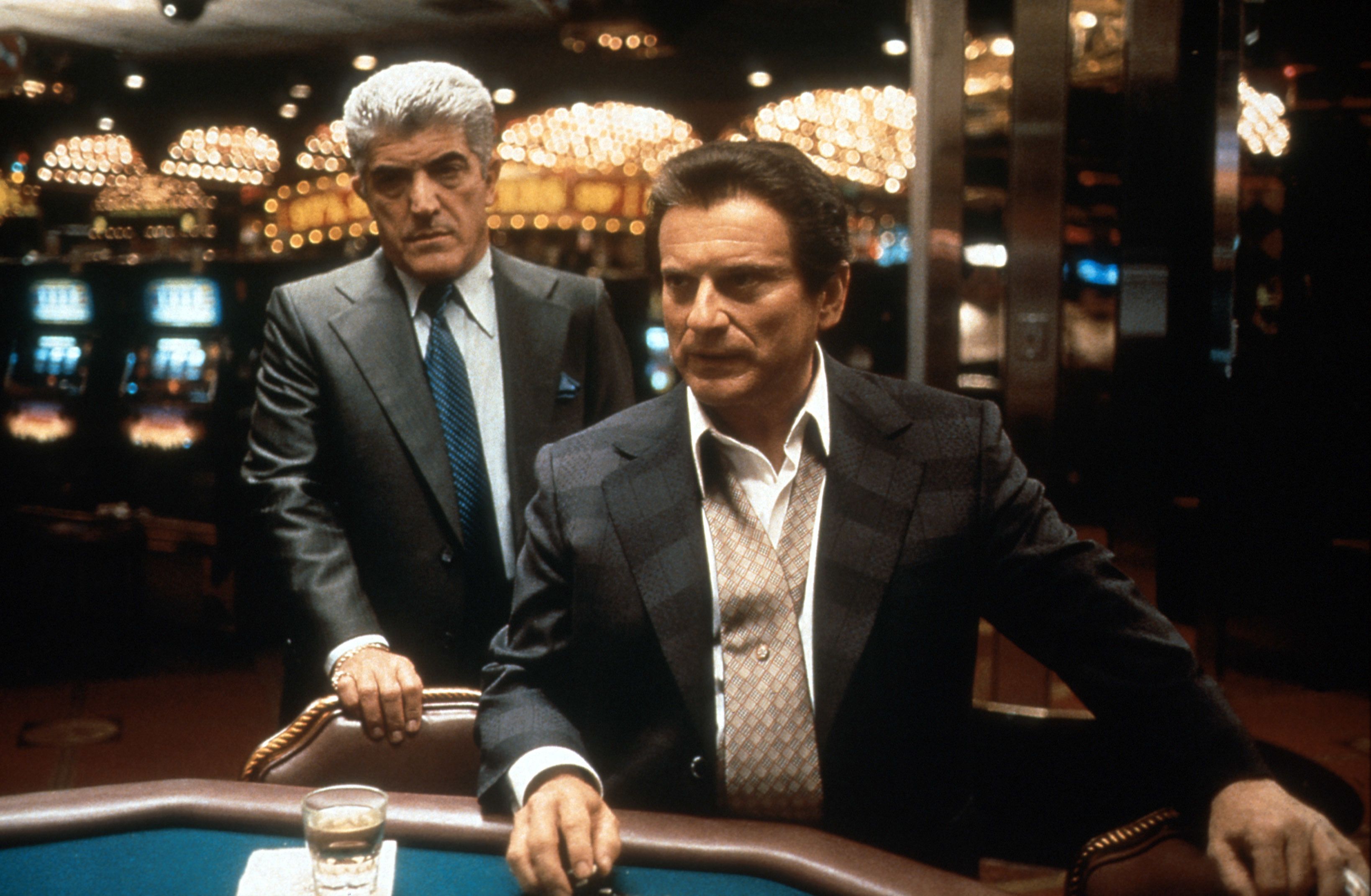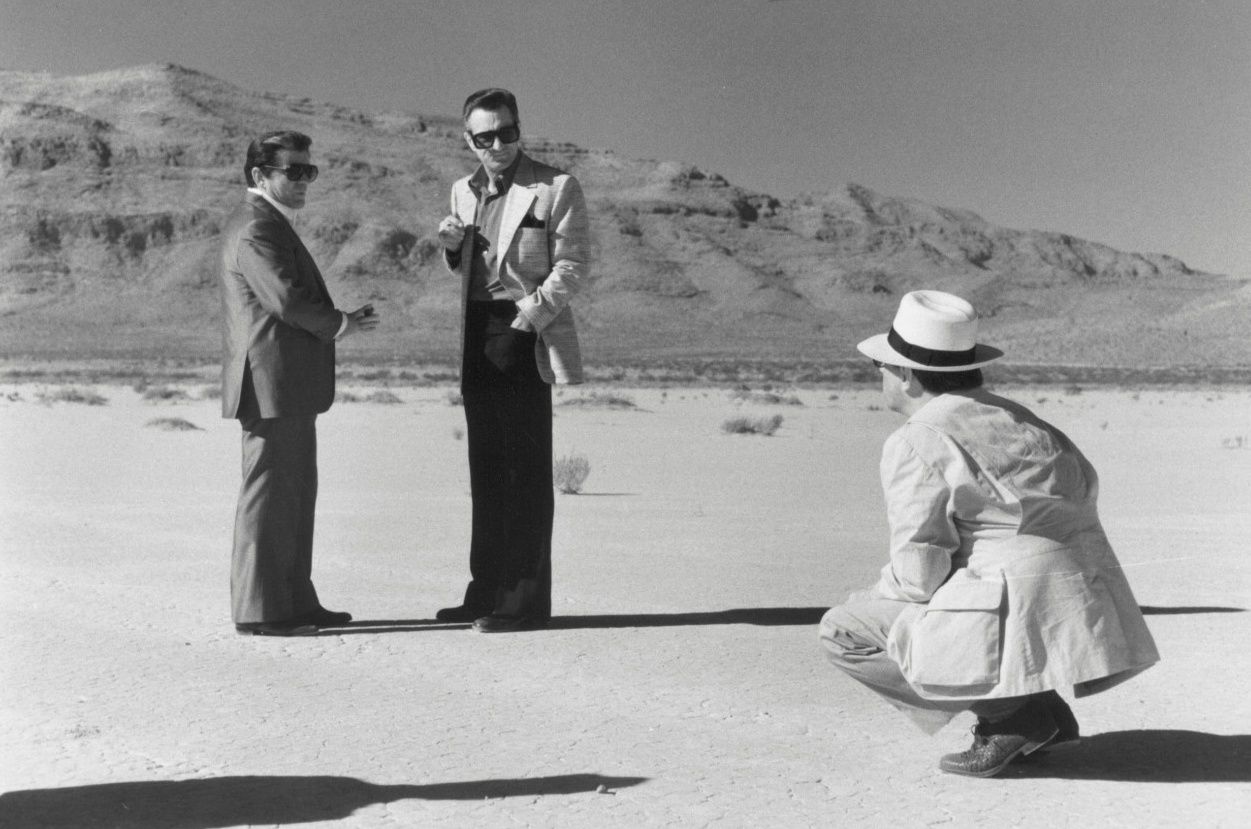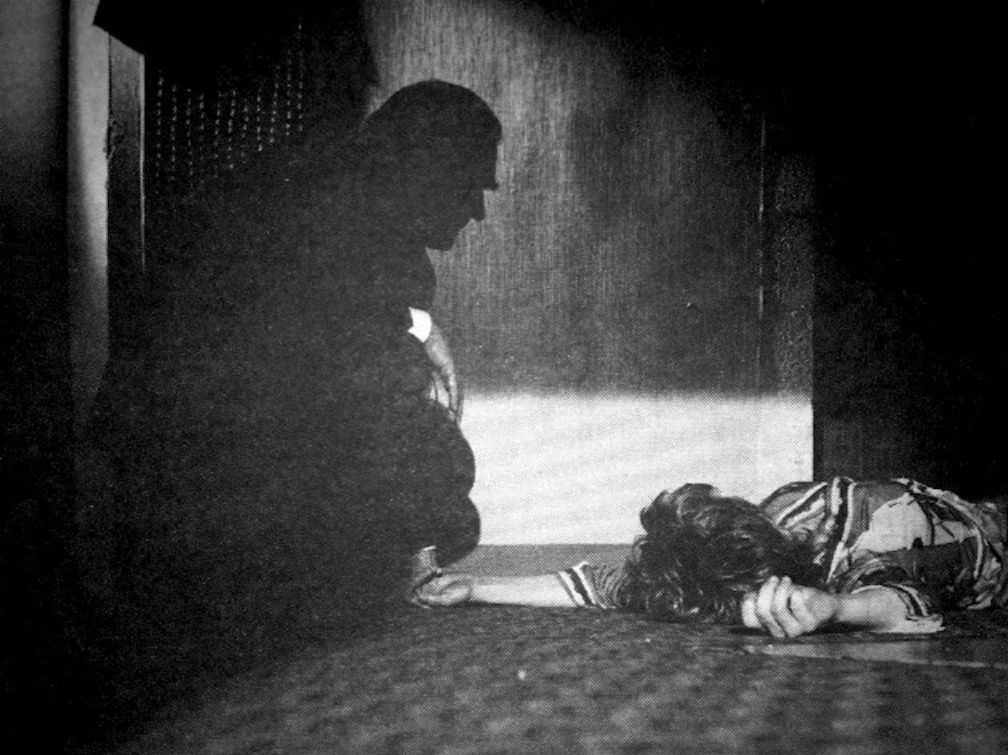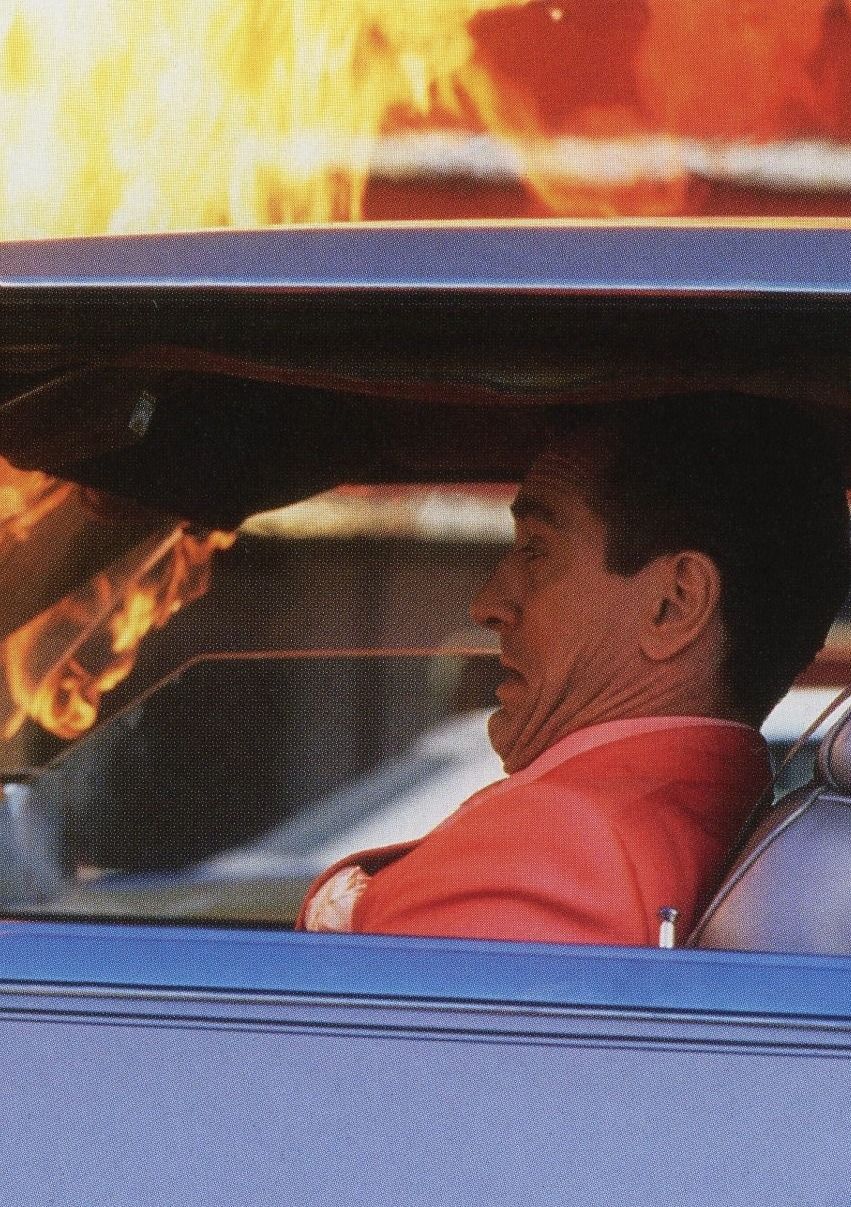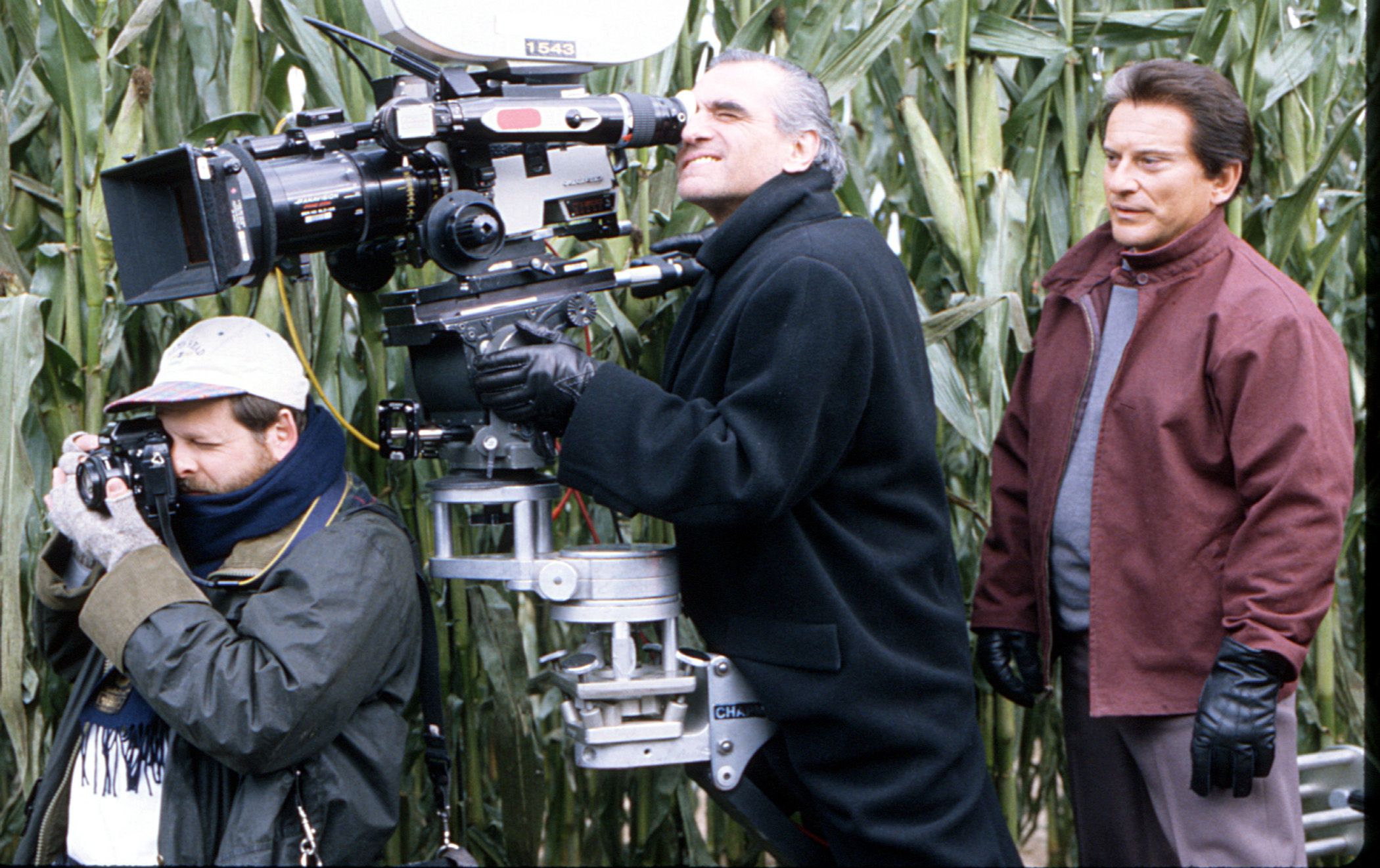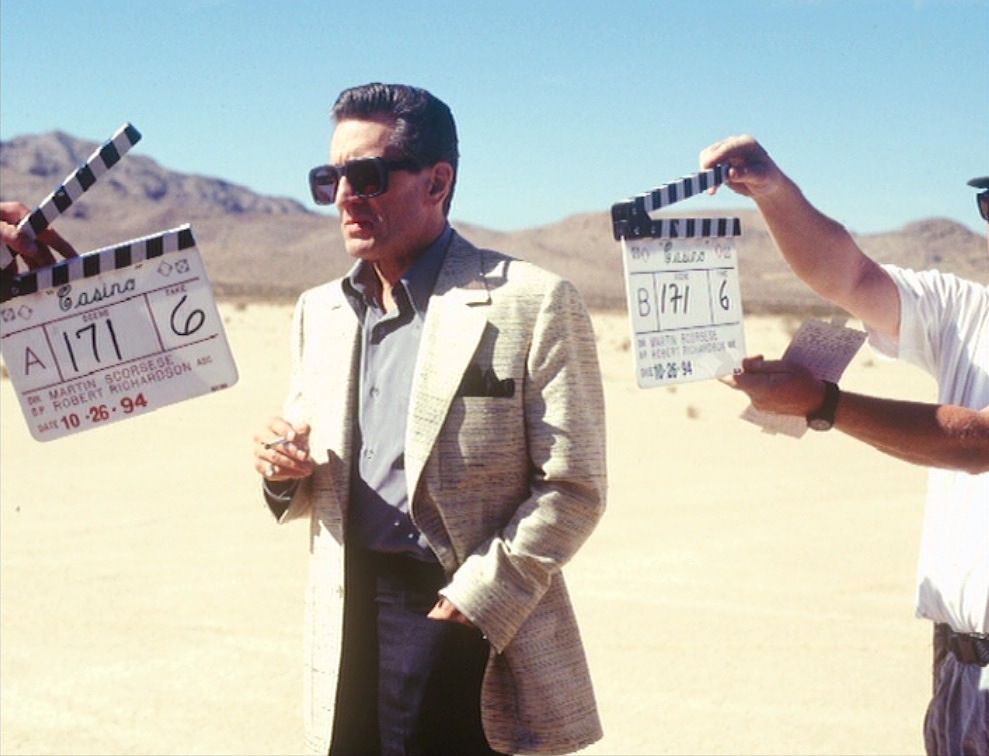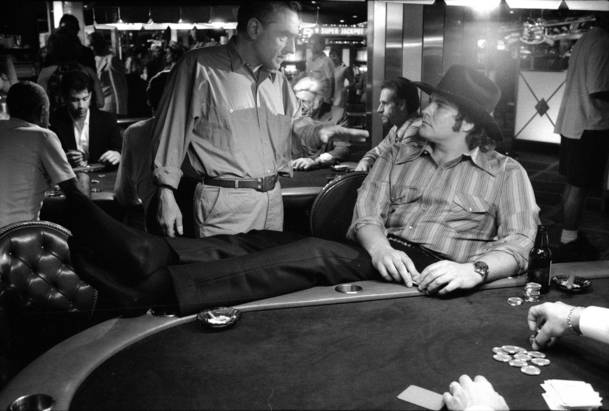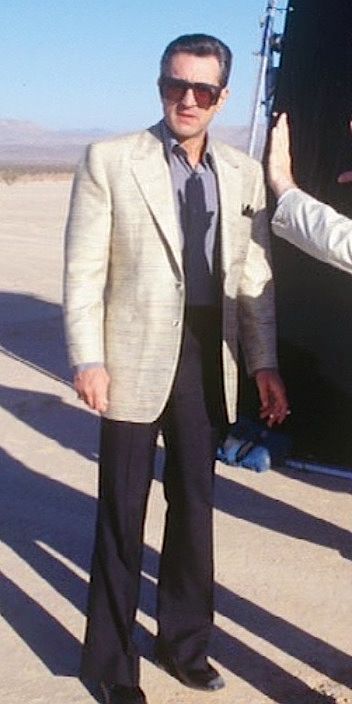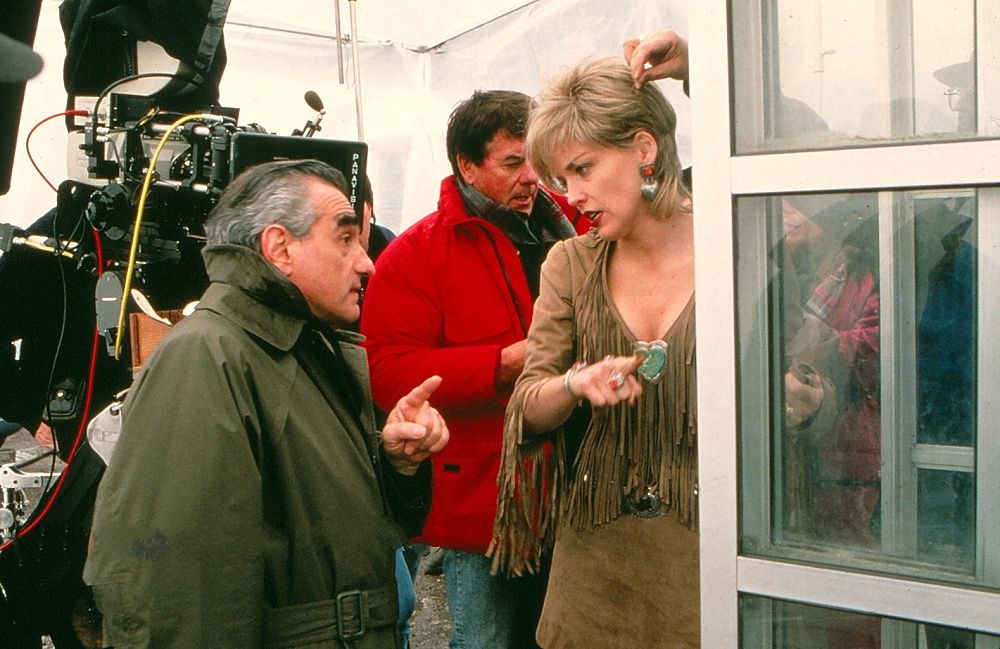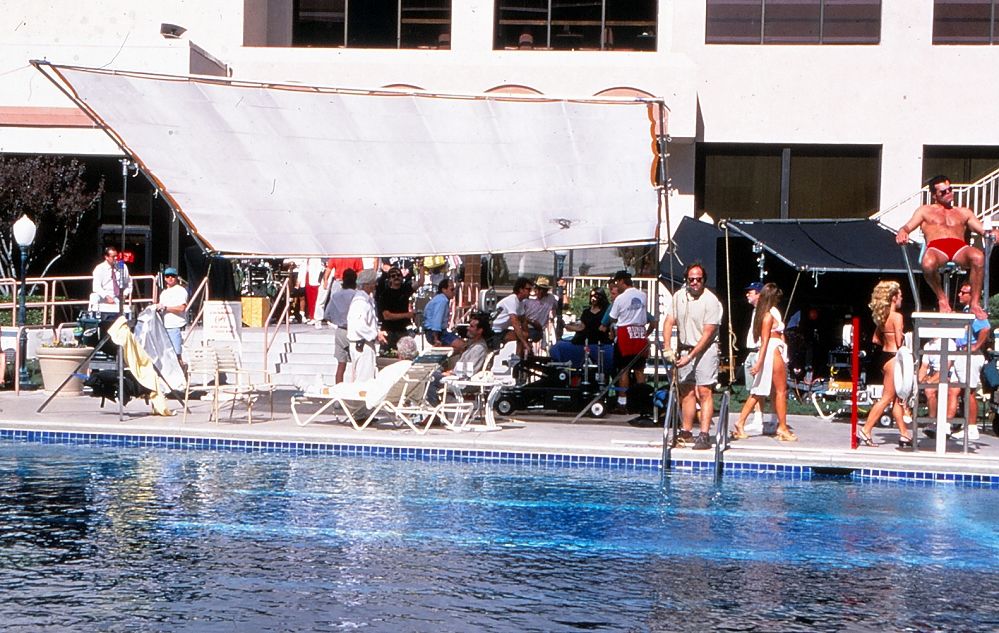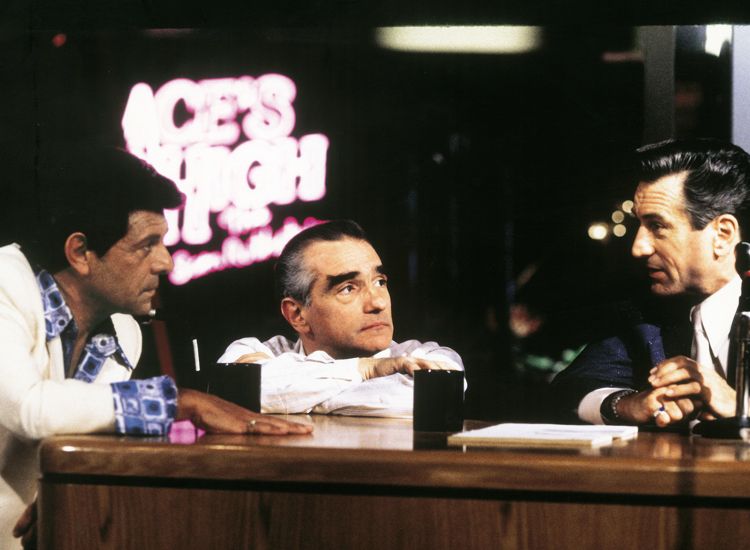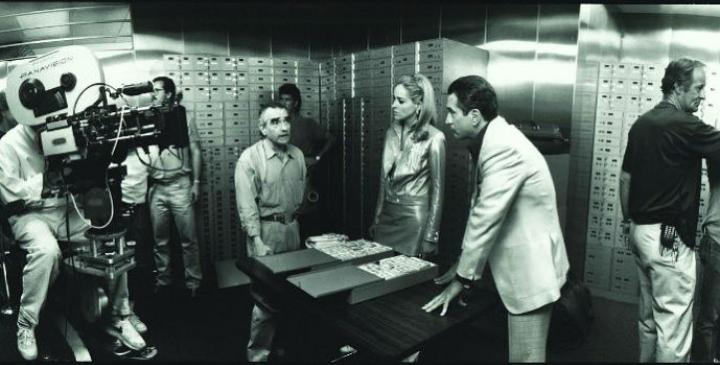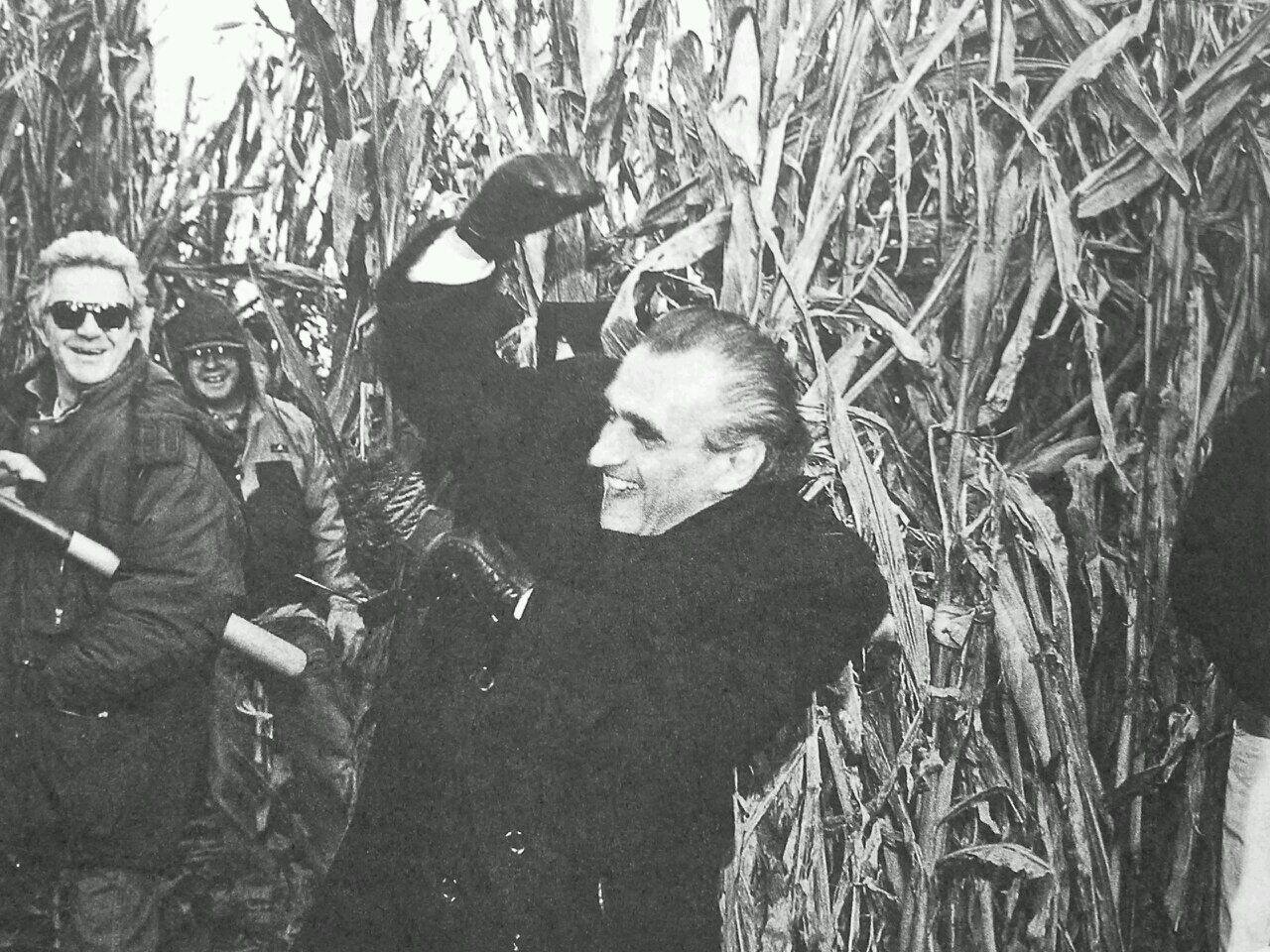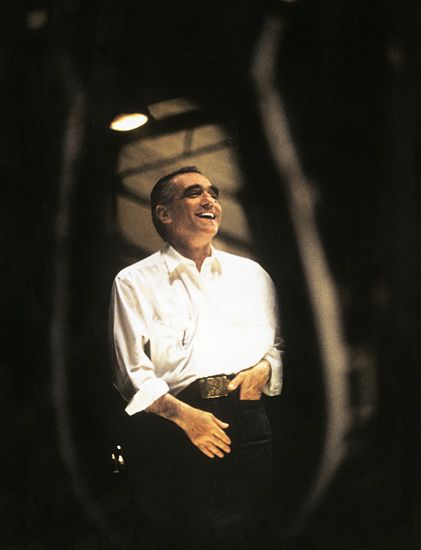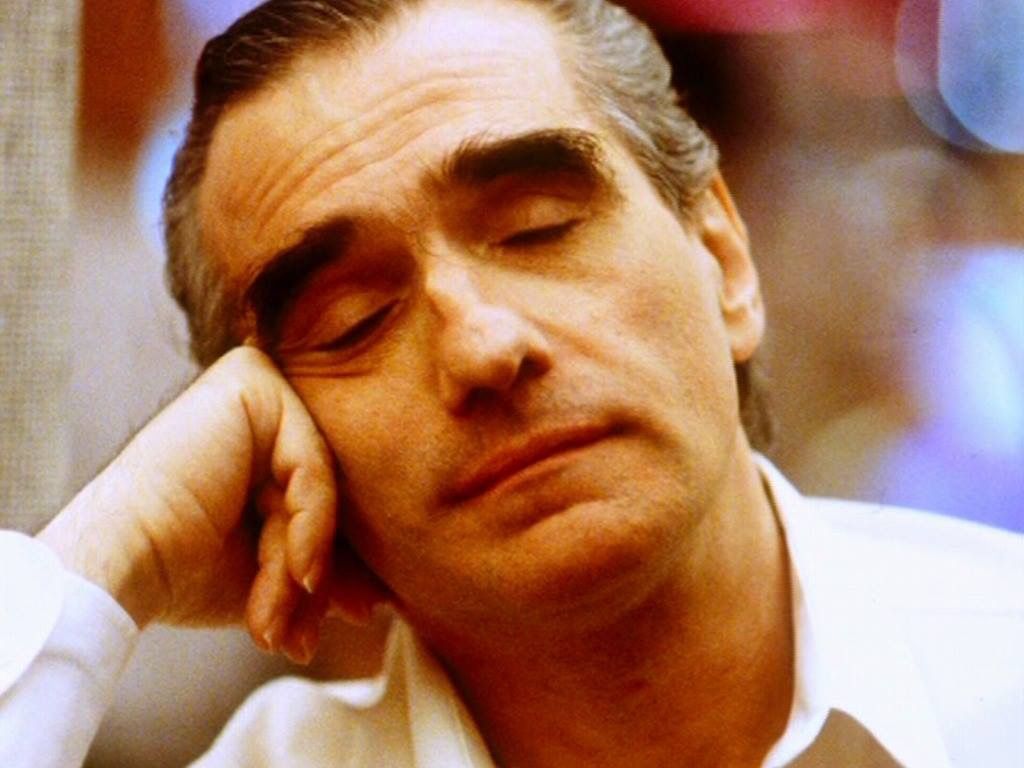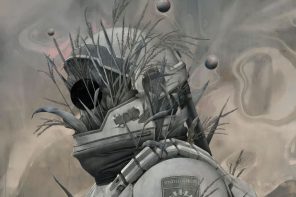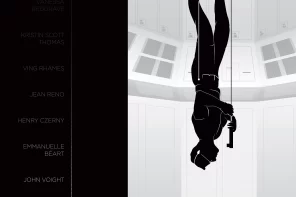By Tim Pelan
This story has to be on a big canvas. There’s no sense in my getting Bob De Niro and Joe Pesci and making a 90-minute picture about only one aspect of one story out of Vegas for the past 40 years. It has to be set in the context of time and place, it has to be about America. Otherwise, why make another mob story? I couldn’t care less. —Martin Scorsese
Casino in some respects is director Martin Scorsese dialing Goodfellas up to 11. Oh, you want the mob life? Well here it is in Chairman of the board brashness and lurid VEGAS BABY! sindulgence, where gambling king and long-term gaming licensee in waiting Sam “Ace” Rothstein (Robert De Niro) funnels money out the back door of the fictional Tangiers hotel he all but runs for the mob elders back East. To him, it’s a “morality carwash.” There’s almost too much story to cram into Casino, with multiple back-and-forth narration dumps from Ace and best friend from “back home” Nicky Santoro (Joe Pesci), and virtually wall to music and songs, exhaustively sourced by Scorsese himself with musician Robbie Robertson. Perhaps that’s the point—Vegas, whether wilder and Mob run, or a homogenized “Disneyland” as Ace disparages when big business and their own greed and carelessness finally squeezed the bosses out, has always been about sensory overload. Critic David Thomson perhaps has the right idea, revisiting the film often, but in chunks—“half an hour here or there, passages, riffs, routines, ‘numbers’ if you like—and I think that references to music are vital,” he says. It’s the sensation, the feeling you get from listening to a piece of music over and over again. From the damning final chorus of Bach’s St. Matthew Passion in the opening scene, where Ace gets blown up in his car and goes hurtling through a Saul and Elaine Bass designed inferno of flames and Vegas strip—Bad Men before Mad Men; to the tapestry of hooks and grooves that fit the mood and glide of a dream town ripe for the picking. “I was very lucky to be able to choose from over forty years of music and in most cases to be able to get it into the film,” the director recounts in Scorsese on Scorsese. “Certain songs and pieces of music, when you play them against the picture, change everything. So it’s very, very delicate. In Goodfellas the sound is more Phil Spector, while in this picture it’s more the Stones, especially “Can’t you hear me knocking?” which is a key song in the film.” Make hay while the desert sun shines, baby.
The film is based on the true story of Frank “Lefty” Rosenthal, who the mob employed to take control from the Teamsters in Las Vegas in 1971, running a number of casinos beginning with the Stardust. His muscle (who himself muscled in, unofficially) was his childhood friend from Chicago, Tony Spilotro—our “heroes” are based on these guys. Let’s say a number of things went wrong with the dream ticket—a disgruntled hood who travels between Kansas and Vegas foolishly keeps a record of expenses owed; the greedy mob bump off Kevin Pollak’s straight hotel frontman Phillip Green’s previously unknown former business partner Anna Scott when she wins a legal case against him for her share; a wiretap on an unrelated murder picks up the aforementioned hood grumbling about being stiffed for money; and so on. For Spilotro, his main weakness was falling for Geri McGee, a “chip hustler,” hooker and topless dancer (portrayed as Ginger, by a terrific Sharon Stone). He married her, setting aside money and jewelry in her name, but actually his safety net, but their marriage collapsed into a Taylor and Burton-esque spiral of recriminations, alcoholism, control freakery and distrust, Geri turning for solace to Tony (as happens in the film).
Crime writer Nicholas Pileggi was in the process of turning this complex tale into a book, and ended up collaborating with his Goodfellas partner Scorsese again on a screenplay, the two writing together over an intensive five-month period in 1994. Characters were reshaped and reimagined, sometimes several condensed into one. Scorsese and Pileggi walked a legal tightrope, having to note that the film was “adapted from a true story” rather than “based on a true story.” This does lead to the amusing screen title substitute of “Back home” for Chicago at one point.
Scorsese thought of the story as Old Testament-like in its tale of gaining Paradise then losing it through greed and pride—the fictional Tangiers eventually being torn down like the Tower of Babel for a safer, theme park-like experience, the mob bosses and their cronies scattered across the desert plains, no longer speaking from the same playbook. The film opens with a sweeping aerial view of the desert, then the strip lights at night, seductive, but illusory. “Sam is given paradise on earth,” Scorsese said. “In fact, he’s there to keep everybody happy and keep everything in order, and to make as much money as possible so they can take more on the skim. But the problem is he has to give way at times to certain people and certain pressures, which he won’t do because of who he is. When people warn him about Ginger, he says, ‘I know all the stories about her, but I don’t care; I’m Ace Rothstein and I can change her.’ But he couldn’t change her. And he couldn’t control the muscle—Nicky—because if you try to control someone like that you’ll be dead.”
Ace, of course, doesn’t die in that opening explosion. When the dream turned sour someone attempted to take his life with a car bomb, but that particular model had a steel plate beneath the driver’s seat which saved him. When we see it again, it happens in the way Rosenthal remembered it, vividly, with flames starting from the air-con unit. Then he saw his sleeve on fire and he opened the door and rolled out. Two Secret Service men who just happened to be inspecting the hotel ahead of a visit from President Reagan pulled him clear as the car finally went up. “Once you realize you could have been killed, you remember all the details.”
Recently critic Matt Zoller Seitz screened Casino at New York’s IFC Center in the presence of Pileggi. One viewer shared some interesting thoughts on Twitter, @ZakkirGanesh. He considered that, “the character of Ginger reminded me of General Ripper in Dr. Strangelove. An unstable force that helps undo the system, but also represents the same spirit that created the system in the first place. The Doomsday device is meant to prevent war in a way that only warmongers could conceive of. And Ripper is exactly the kind of warmonger who could go too far and set it off in the most foolproof way. Likewise, the entire Casino operation is driven by nothing more than greed, however respectable its architects would like to be about it. But Ginger is driven by greed so insatiable that eventually even her initially respectable aura gives way to something just pathetic. And in the process, she is the edge-case that no foolproof system can ever account for. Ace was so used to predicting wins and losses, he assumed he could figure her out, but she was, for better or for worse (mainly worse), the most irrepressibly human of all of them. And that messy humanity that you can’t bet on or control for, is what helps pull the ground out from under all of them.”
Ace and Ginger have a child, Amy, but Ginger feels trapped in the marriage, spiraling out of control on alcohol and cocaine, neglecting Amy. At one point (and this was true!) Ace comes home to find Amy tied to her bed with stockings while Ginger paints the town red (“The kid was asleep,” she slurs, figuring she’d be home before she woke up). Ace tries to have her page him every time she goes somewhere. Ginger pines for her pimp (a slimy James Woods), who conspires with her to take the kid and leave, emptying her safety deposit box. She even comes on to Nicky with sexual favors to help her. The cuckolded Ace has Nicky barred from the Tangiers. Stone auditioned for Casino against the advice of her people, who saw Ginger as too unsympathetic (she went on to win a Golden Globe and was Oscar-nominated). She felt she was in the right place at the right time, telling The Guardian, “I think for a long time people just did not know what to do with me. I looked like a Barbie doll and then I had this voice like I spend my life in a bar, and I said things that were alarming and had ideas that didn’t make sense. And finally I got together with Marty and Bob and they were like, ‘Give it all to us, baby, just let her rip if you’ve got it, we want it, let’s see what you can do.’” Scorsese told The New York Times that he cast her because of her presence—“You can believe that she is the most respected hustler in Vegas.” Sight and Sound said of her varied performance, from confident hustler to lonely, self-pitying trapped bird in a gilded cage that “Stone attacks the role with a voracious energy; her performance has a terrifying emotional range, from the snarl to the whimper.”
Meanwhile the legal system refuses to grant Ace his gaming license so he starts his own entertainment TV show from the casino to keep his (in his eyes) persecution over nothing from the politicians in the public domain, to the mob’s embarrassment. Amusingly, when Rosenfeld launched this real-life TV entertainment it was hit by technical glitches, the station instead transmitting, fittingly, on the opening night, Anthony Mann’s The Fall of the Roman Empire. Nicky’s own strong-arm enforcement money rackets are drying up, and he also comes under the watchful eyes of the Feds (as in real life, the agents tailing him by light plane run out of fuel and have to abandon the plane on the golf course next to Nicky’s home. Insouciantly, he calls to his tee-mates, “100 bucks to whoever hits the plane first.”). But all good things must come to an end, and for Nicky, those desert holes he kept digging in advance will come back to haunt him.
“They (Ace and Nicky) both buy into a situation and both overstep the line so badly that they destroy everything for everybody,” Scorsese recalled to Ian Christie. “A new city comes rising out of the ashes. Who knows what the realities are there now, where you’ve gone from a Nicky Santoro to a Donald Trump? Who knows where the money’s going? But I’m sure it’s got to be very, very good somehow for those entrepreneurs coming in with the money. You’ll probably see a film in 15 years exposing what they’re doing now. What we show in this film is the end of the old way and how it ended. They got too full of pride, they wanted more. If you’re gambling you want more, like the Japanese gambler Ichikawa, who bets less money than he normally would bet when he’s tricked into coming back. But for him it isn’t winning 10,000, it’s losing 90,000, because normally he bets 100,000.” Ace opines, “In the end, we get it all.”
Ace is persnickety, everything has to be just so, from his choice of wristwatch that matches his shirt or tie (“We had fifty-two changes for Bob, which was a lot, but in reality the person he’s based on had even more amazing clothes.”) to insisting the number of blueberries in each muffin from the kitchens exactly match, and weekly weigh-ins for the chorus line. Ace even hangs his pants up when he’s working at his desk so they don’t get creased. The Tangiers has to be the best place on the strip. Rita Ryack and John Dunn did the costumes, reputedly for a $1 million budget: vibrant mustard yellows and electric blues, crimson blazers for Ace, glamorous cocktail dresses then slightly tackier white leather miniskirts and thigh-high boots for Ginger. In the end she’s scrabbling around in a “David Bowie-type gold lame outfit,” a little baggy to show her drug-infused weight loss. Scorsese shot in a real casino, often in the early hours, dressing the prominent extras with authentic 70’s costumes, obscuring the background artists with detail happening in the foreground.
Scorsese’s regular cinematographer Michael Ballhaus was unavailable so the director turned to Robert Richardson, who he had not worked with before, but knew of through his work with Oliver Stone. They shot on Super 35mm film and in the 2.35:1 anamorphic aspect ratio. From The Directors Series: “By this point, Scorsese has distilled his style into an eclectic mix of crane shots, Steadicam moves, whip-pans, canted angles, freeze frames, speed ramps, iris shots, split-focus diopter compositions, and his signature ‘scream-in’ technique (in addition to the new usage of grandiose helicopter-mounted shots). Casino is less of a film with linear scenes conveying plot than it is one long montage encompassing a decade of high times and bad behavior, and regular editor Thelma Schoonmaker expertly puts every little piece in just the right place, making sense out of what must’ve been an incomprehensible jumble of dailies and fashioning it into the definitive Las Vegas film.”
Casino would be Scorsese and De Niro’s last collaboration (feature-wise–there was the short film The Audition) until the much anticipated The Irishman, a decades-spanning tale perhaps even more ambitious which also reunites them with Pesci in the tale of Frank Sheeran (De Niro), the Irishman of the title, a handler of matters (i.e. killer) for mafia bosses Russell Bufalino (Joe Pesci) and Angelo Bruno (Harvey Keitel) with a side-bar business relationship with Teamster boss Jimmy Hoffa (Al Pacino). All main actors de-age to play themselves with “youthification” VFX wizardry. It’s perhaps a fitting culmination of underworld themes explored between director and muse, Scorsese telling Empire magazine that it is a surprisingly tender, remorseful look back at a hard life choice. “The brashness of the cowboys, a Tommy De Vito in Goodfellas, running out shooting guns in the air, we’ve all seen it. We’ve done it ourselves, meaning in the world and in cinema. We were the wild ones, in a way. But now we’ve reached a point where we can look back. Not even look back, but look inside. Because we have no more time.” In the end, everybody pays. Everybody “gets it all.”
Tim Pelan was born in 1968, the year of ‘2001: A Space Odyssey’ (possibly his favorite film), ‘Planet of the Apes,’ ‘The Night of the Living Dead’ and ‘Barbarella.’ That also made him the perfect age for when ‘Star Wars’ came out. Some would say this explains a lot. Read more »
Screenwriter must-read: Nicholas Pileggi & Martin Scorsese’s screenplay for Casino [PDF]. (NOTE: For educational and research purposes only). The DVD/Blu-ray of the film is available at Amazon and other online retailers. Absolutely our highest recommendation.
 Loading...
Loading...
“’Wiseguy’ is a book about organized crime and how it works. And you see it from real people. Casino was a much more complicated story because it was really the story of an industry, how that industry works and the history of that industry, otherwise you don’t understand it. But I couldn’t just write this long, sprawling thing. I had to find people through whom to tell the story. That is the key if you write non-fiction. Who are the people through whom we can tell the story? I worked on Casino for years until I found the people through whom I could tell the story of the casino industry. I had the man who was the master gambler who they needed to run the casinos, the mobsters who put together the connections, the Teamsters to make the loan, the front man who got the money from the mobsters and the Mafia muscle-man who was there to keep everybody in place. And he falls in love with the gambler’s wife and it brings everything down. It was the perfect dramatic story through which we could tell the story of the casino industry and that’s what we made a movie about. There was a lot of criticism that there were no heroes. Indeed, there were none. I like Frank Rosenthal (name changed to Ace Rothstein in the film) very much, I think he’s a charming smart guy but lots of people just hated him. And the way Bob played him, he played him just like Lefty Rosenthal. He’s not an endearing person at all, he’s mean, he’s mean to his wife, he’s obsessive about numbers. And Tony Spilotro was a total psychopath. They weren’t nice people but the book is based on reality. A lot of the lines they say in the movie, they said in real life.” —Nicholas Pileggi
Author Nicholas Pileggi talks about his book, Casino: Love and Honor in Las Vegas and his collaboration with Martin Scorsese on the movie, which is premiering almost simultaneously with the book’s release.
Scene 166–170: Desert Argue. With Scorsese’s own handwritten notes and drawings.
Martin Scorsese’s Testament, by Ian Christie. This article was originally published in Sight & Sound, January 1996.
~ ~ ~
What was the hook that persuaded you to tackle another mafia subject after Goodfellas?
The first newspaper article Nick Pileggi showed me was about the police covering a domestic fight on a lawn in Las Vegas one Sunday morning. And in that article it slowly began to unravel, this incredible ten-year adventure that all these people were having, culminating in this husband and wife arguing on their lawn, with her smashing his car, the police arriving, and the FBI taking pictures. As you work back to the beginning, you find this incredible story with so many tangents, and each is one more nail in their coffin. It could be the underboss of Kansas City, Artie Piscano, constantly complaining that he always had to spend his own money on trips to Las Vegas and never got reimbursed. Or it could be the unrelated homicide that made the police put a bug in the produce market that Piscano kept in Kansas City. Even they’ve forgotten about it, but it picks up all his complaining and alerts FBI men round the country to all these names. They’re surprised to hear the names of the Vegas casinos being mentioned in a Kansas City produce market. What’s the connection? Then, quite separately, a court decrees that Anna Scott should have her share of the money as a partner of the president of the Tangiers. But instead of settling with her, the mob shoot her, which also really happened. This then brings police attention to their frontman, the president, although he was in no way involved in the decision to kill her, and he begins to realize what’s going on, although there’s nothing much he can do about it. And then you have Ace Rothstein and Ginger and Nicky Santoro, all very volatile characters. I just thought it would be a terrific story.
How much is based on real characters and events?
Pretty much everything. Piscano is Carl DeLuna, who kept all those records. Mr. Nance, who brings the money from the casino to Kansas City, is based on a man named Carl Thomas, who was recently killed in a car crash. Mr. Green, the Tangiers president, Rothstein, Ginger, Nicky Santoro and his brother—these are all based on real people. Sometimes things that happened in Chicago are placed in Vegas. We did have some problems about being specific, which meant saying “back home” instead of Chicago, and having to say “adapted from a true story” instead of “this film is based on a true story,” which was the lawyers’ language.
Was Las Vegas unfamiliar territory for you?
I’m pretty familiar with the characters around the tables and in the offices, but the actual place, and the gaming, were new to me. What interested me was the idea of excess, no limits. People become successful like in no other city.
It gives Ace a chance to create something, rather like an oldtime prospector going west, who lands in a small town and by sheer hard work makes his fortune. But because he makes the classic mistake of loving without being loved, he falls.
Well, it’s his own fault. He says, “I know all the stories about her, but I don’t care, I’m Ace Rothstein and I can change her.” But he couldn’t change her. And he couldn’t control the muscle—Nicky—because if you try to control someone like that you’ll be dead. When his car was blown up it was pretty obvious who gave the order for that. But as Nicky says at one point in the film, so long as they’re earning with the prick they’ll never OK anything—the gods, that is—meaning they’ll never authorize killing him. But Nicky likes to be prepared, so he orders two holes to be dug in the desert. That’s the way they talk. This is the actual dialogue from a witness protection program source that we had.
It’s really Sodom or Gomorrah, surrounded by the desert, isn’t it?
Yes it is. We don’t want to lay it on too heavily, but that was the idea. Gaining Paradise and losing it, through pride and through greed—it’s the old-fashioned Old Testament story. Ace is given Paradise on Earth. In fact, he’s there to keep everybody happy and keep everything in order, and to make as much money as possible so they can take more on the skim. But the problem is that he has to give way at times to certain people and certain pressures, which he won’t do because of who he is.
What about the whole country-club strand? Is this because he’s Jewish and wants to be accepted socially?
He says when he accepts that plaque, “Anywhere else I’d be arrested for what I’m doing. Here they’re giving me awards.” This is the only place he can use his expertise in a legitimate way, and so become a part of the American WASP community. That’s why Nicky tells him in the desert, “I’m what’s real out here. Not your country clubs and your TV show. I’m what’s real: the dirt, the gutter, and the blood. That’s what it’s all about.”
It’s a great scene in a classic Western setting.
That’s where they had to go to talk—in the middle of this desert. And Nicky had to change cars six times. I always imagined that the Joe Pesci character must be so angry, and getting angrier as he changes each car, until he gets out of the last one and De Niro can’t say a word when he lashes right into him. But you know in this case I’m on Nicky’s side. The rest is artifice, and if you buy into it it’s hypocrisy. Know where it’s coming from and know what the reality is. Don’t think you’re better than me, or than the people you grew up with.
This creates the same moral dissonance that was so powerful in Goodfellas, where you want to see someone succeed, but it’s the wrong business!
Very often the people I portray can’t help but be in that way of life. Yes, they’re bad, they’re doing bad things. And we condemn those aspects of them. But they’re also human beings. And I find that often the people passing moral judgment on them may ultimately be worse. I know that here in England there were filmmakers and critics who felt I was morally irresponsible to make a film like Goodfellas. Well, I’ll make more of them if I can. Remember what happens at the end of the movie, where you see Nicky and his brother beaten and buried. That’s all based on fact—I saw the pictures of the real bodies when they dug up the grave. Now it’s shot in a certain way, very straight. And I happen to like those people. Nicky is horrible. He’s a terrible man. But there’s something that happens for me in watching them get beaten with the bats and then put into the hole. Ultimately it’s a tragedy. It’s the frailty of being human. I want to push audiences’ emotional empathy with certain types of characters who are normally considered villains.
You go to considerable lengths to make Nicky an attractive figure. He even comes home every morning and cooks breakfast for his son…
Based on the real man, who did that. It’s an interesting dilemma for both of them. They both buy into a situation and both overstep the line so badly that they destroy everything for everybody. A new city comes rising out of the ashes. Who knows what the realities are there now, where you’ve gone from a Nicky Santoro to a Donald Trump? Who knows where the money’s going? But I’m sure it’s got to be very, very good somehow for those entrepreneurs coming in with the money. You’ll probably see a film in fifteen years exposing what they’re doing now. What we show in this film is the end of the old way and how it ended. They got too full of pride, they wanted more. If you’re gambling you want more, like the Japanese gambler Ichikawa, who bets less money than he normally would bet when he’s tricked into coming back. But for him it isn’t winning ten thousand, it’s losing ninety thousand, because normally he bets one hundred thousand.
It’s a neat little parable about gambling.
We always had problems with where it was going to be placed in the structure. But I said it’s very important to keep the move into Bob’s face when he says, “In the end we get it all.” They do, they really do. What an interesting place, because they’re a bunch of cheats, watching cheats, watching cheats. Ace Rothstein and those guys know how to cheat, with handicapping and basketball games. They make it so natural that you wouldn’t be able to tell whether the game is fixed. I’m sure he has that ability.
There’s a fantastic symphony of looks in the film, with everyone watching everyone, and you push it and push it until we reach—
—the all-seeing eye. That’s when he sees her for the first time. Before they had the video eye-in-the-sky, they had men with binoculars who had been cheaters up on the catwalks, trying to find other cheaters. I just thought it was really wonderful, with nobody trusting anybody.
There’s another documentary thrust in the film: how money gets skimmed and multiplied and diffused, and then distributed in equally bizarre ways.
That was twenty years ago, before the old mob lost their control. At that time every casino was “owned” by some mob from a different part of the country. The Tangiers is fictional, but there were four—the Stardust, the Fremont, the Frontier, and the Marina—which the Rothstein character controlled. So we just made them one giant hotel and combined all the elements. Where else could a great handicapper become the most important man in the city, with total control? We tried to show how far his control ran, even over the kitchen and the food. Insisting on an equal number of blueberries in each muffin may seem funny, but it’s important because if the muffins and the steaks are good the people who are playing there will go and tell others. It’s not just paranoia and obsessive behavior—there’s a reason: to make the Tangiers the best place on the Strip.
And his TV show really existed?
Totally real. When everybody wants him to quieten down, he goes on television. He forgets why he’s been put there, and he gets overblown, with the clothes he wears and everything, and the old guys “back home,” those guys said, “What’s he doing, going on television?” The real show wasn’t very good, as I think you can tell…
Shades of Rupert Pupkin in The King of Comedy.
Exactly. But he thought of it as a place to be heard, which is what it became.
The bosses are seen in some highly stylized ways. When we see them around a table, they’re like a group painted by Frans Hals.
Yeah, they’re definitely old-world.
Then we see them in another mysterious nowhere place, with stark almost silhouette lighting like a scene from Fritz Lang.
That’s the back of the garage, and Bob Richardson lit it like that. It’s where Remo says, “Go get them,” and they put the guy’s head in a vice, not that they intended to do that. But after two days and nights of questioning they didn’t know what else to do.
This is so excessive that we know it’s got to be real, because you wouldn’t invent it. But it also seems to belong to a Jacobean horror tragedy.
It really does. The incident actually occurred in Chicago in the sixties. There was a Young Turk argument which ended with guns and two brothers and a waitress were killed. It caused such outrage that they wanted the men who were with him also, and they finally got them and killed them all. But Joe found the human way of playing the scene: “Please don’t make me do this.” But he’s a soldier and he has to take these orders, and he has to get that name, otherwise his head is in the vice.
Although Ginger is as important a character as Ace and Nicky, we really only see her through their eyes and so she remains more of a mystery. Is she hustling him from the start, or does he kill whatever chance they had?
She tells him exactly how things are in that scene where he proposes. Reaching the age of forty, if you find someone maybe you try to make it work in a reasonable way. I think they may have had a chance, if it wasn’t for that city and what they were doing in it. Although I think there’s something in Ace’s character that ultimately destroys everything.
Does it get worse, as he gets more and more wrapped up in his role as casino boss?
I think he’s responsible for the emotional alienation. You get it when she goes to the restaurant and she says, “I’m Mrs. Rothstein,” and the other lady says, “Well, you might as well get something out of it.” It’s how he treats her. He won’t let her go. If he lets her go, he believes he’ll just never see her again. He’ll hear from her through a lawyer, but he’ll never see her again. Their daughter Amy is unfortunately just a pawn to be used. By the last third of the film, Ginger is definitely disturbed, she’s no longer in her right mind. Whether it’s from drugs or drink doesn’t matter, she’s completely gone. It doesn’t excuse anything she does, but it does heighten the horror of what’s going on—like tying the child up.
That really happened too?
Yes, only I think the child was younger (the real couple had two children). It’s not something you’d invent; nor her reaction to Ace in the restaurant when she says, “Oh for God’s sake, the babysitter wasn’t there, and it was only for a little while, I was going to come right back.”
Sharon Stone gives a very committed performance which shows she’s got a range which hasn’t always been called upon.
I agree. De Niro really helped her through those scenes. He’s very generous with her and you can see how he’s always helping. It’s a scary role, a tough one—like when she takes cocaine in front of the child: that was her choice.
She has to spend nearly a third of the movie in a state of falling apart.
Yes, and she did that with her whole body and with the clothes. She worked with the clothes, like that David Bowie–type gold lamé outfit she’s wearing for the last third of the picture. It’s a little baggy in places, because she tried to make herself look as bad, or as wasted, as she could. You could make ten films about each of those characters, all different, and I don’t know if I did justice to any of them. I just wanted to get as much in as possible, plus I wanted to get all of Vegas in there as well. And also the whole climate of the time, the seventies.
You shot the whole film in Las Vegas. Did you shoot in a real casino?
Oh yes. And we shot during working hours. Barbara De Fina figured out that the extra time it could cost would probably be the same as to build one. And you won’t have the electricity and the life around you, which is what we got. We would fill the foreground with extras dressed in seventies costumes, and the background would sort of fall off. Sometimes we shot at four in the morning. I really love the scene when Joe comes in with Frank Vincent and they’re playing blackjack, even though he’s banned from the place, and he’s abusing the dealers. That was four o’clock in the morning, and you hear someone yelling in the background because he’s winning at craps. The dealer went through the whole scene with Joe, who was improvising, throwing cards back at him and saying the worst possible things. Halfway through the scene, the dealer leaned over to me, and said, “You know, the real guy was much tougher with me—he really was uncontrollable.”
Why does the film have to be so long?
You have to work through the whole process of these three people who can’t get away from each other. Every way they turn they’re with each other. It’s not even a story about infidelity. It’s bad enough that they both were unfaithful to each other—the marriage was in terrible shape as it was—but worse that she starts with Nicky, because Nicky is the muscle. If anybody can get her the money and jewels it’s Nicky.
The most remarkable thing about the film’s structure is that you start with Ace being blown up.
In the very first script we started with the scene of them fighting on the lawn. Then we realized that it’s too detailed and didn’t create enough dramatic satisfaction at the end of the picture. So Nick and I figured we would start with the car exploding, and he goes up into the air and you see him in slow motion, flying over the flames like a soul about to take a dive into hell.
It’s like one’s whole life passing before you in an extended moment. But you show the explosion three times.
That’s right. I show it three times, in different ways. Finally, the third time, we see it the real way. That is how he remembered it. The actual fellow this is based on told me he saw the flames coming out of the air conditioning unit first, and he didn’t know what it could be. Then he looked down and saw his arm on fire and he thought of his kids. The door wasn’t properly locked, so he rolled out and was grabbed by two Secret Service men who happened to be casing the joint because of Ronald Reagan’s visit the following week. They pulled him aside and it was only when the car went up that he realized it was intentional—at first he’d thought it was an accident. That’s why I did all the details. Once you realize you could have been killed, then you never forget those moments.
Did the internal structure of the film change a lot as you worked on it?
Yes, it did, a lot. And that’s where Thelma Schoonmaker came in very strongly, because she hadn’t read the script, but just watched the footage come in and was able to take charge of elements that were in the middle, like the documentary aspects. Thelma and I used to edit documentaries twenty-five years ago, so she’s very, very good at that. It is the most harrowing kind of editing you can do because you’re never sure of the structure and you’re not following a dramatic thread. There’s story, but no plot. So what you’re following is the beginnings of Ace coming to Vegas, then the beginnings of Nicky in Vegas and the beginning of Nicky and his wife in Vegas and their child. Then Ace is succeeding in Vegas, and what’s Nicky doing? He’s sandbagging guys. Ace’s rise culminates with Nicky being banned. Then that takes us to Nicky rising, which is his montage of robbery—“I’m staying here, you’re not getting rid of me.” He creates his alternative empire. Then you start to bring the two tracks together. But up to the point at which Nicky builds his own empire we had a lot of reshuffling of scenes and rewriting of voiceover. Finally, we put all the exposition at the beginning. At first we had split it up throughout the film, but it was too little too late, although on the page it looked all right. So in the end we took the explanation of the skim and moved it up front.
You’ve become really interested in voiceover. What does it do for the spectator?
There’s something interesting about voiceover: it lets you in on the secret thoughts of the characters, or secret observations by an omniscient viewer. And for me it has a wonderful comforting tone of someone telling you a story. And then it has a kind of irony much of the time. Suppose you see two people saying goodnight, and the voiceover says, “They had a wonderful time that evening, but that was the last time before so-and-so died.” You’re still seeing the person, but the voiceover is telling you they died a week later, and it takes on a resonance, and for me a depth and a sadness, when used at moments like that. The voiceover in this particular film is also open to tirades by Nicky. If you listen to him complaining—about the bosses back home, how he’s the one out here, the one in the trenches—then you begin to understand his point of view. Why should I have to work for somebody? Why don’t I go into business for myself? You can see the kind of person he is from these tirades in voiceover.
Did the change in visual style come from working with a new cinematographer, Bob Richardson, or from the subject’s needs?
Well, there are a lot of tracks and zooms; as well as pans and zip-pans. There are also more static angles, cut together very quickly, because of all the information being crammed into the frame. If you did too much moving you wouldn’t be able to see what we’re trying to show. So that became the style—a kind of documentary.
You talked about excess as the keynote of Las Vegas, but the most excessive thing is De Niro’s wardrobe.
That was Rita Ryack, who’s done a number of films with me, and John Dunn also worked with her. We had fifty-two changes for Bob, a lot, but in reality the person he’s based on had many more.
It becomes a visible sign of him going off the rails.
Absolutely. The mustard-yellow suit, the dark navy-blue silk shirt with navy-blue tie, with crimson jacket. We chose the colors very carefully. Our rituals in the morning, once we narrowed down the idea of which outfit, were to choose which shirt, then which tie, then which jewelry. If you look closely, the watch faces usually match the clothes—even the watch he wears when he turns the ignition on. We were always rushed—I just needed a close-up of him turning on the ignition. Then we look at it through the camera, and we think, oh yes—the wristwatch. So we set the angle to show the watch as well as possible, for the short amount of time it’s on. And if you look at the film again, or on laserdisc, you can see a lot of detail in the frames that we put there. Nicky didn’t have that many changes, maybe twenty or twenty-five. And Ginger had about forty I think.
You’ve worked with Dante Ferretti on a number of films. What kind of relationship do you have in terms of planning the overall look of a film?
The casino we used, the Riviera, looked like the seventies, although it was only built in the late seventies. That was the centerpiece. Then we were trying to find houses that were built in the late fifties or early sixties, which are very rare. There was one house which we finally got, and I laid all my shots there, rehearsed, and then about two weeks later we lost it. Then we had to find another house, and finally it all worked out for the best, because that’s the best one we found. It was an era of glitz—a word I heard for the first time in the seventies—and I think you can tell what Dante brings to a film when you just look at the bedroom. Especially in the wide shots, in the scene where she’s taken too many pills and she’s crying, and he’s trying to help her. There’s something about the way the bed is elevated and it looks like an imperial bed, a king’s or a queen’s bed. There’s something about the wallpaper, everything, the dishes on the walls—that says a great deal about character. Dante made it regal, not just in bad taste—even though some of it is bad taste—but the quality is good, and that moiré silk headboard is a backdrop for a battleground, a silk battleground.
I’m interested you say “regal,” because I also found myself thinking the film is about a court, with a king who chooses a consort, and what we see is the rise and fall of a little dynasty.
Exactly. They’re on display all the time. Appearance is everything, to the point where he didn’t want people to smile at him or say hello. You can see it in how he stands and looks around.
The music for Casino uses the same general approach as Goodfellas, but the range is broader—like starting with the St Matthew Passion.
I guess for me it’s the sense of something grand that’s been lost. Whether we agree with the morality of it is another matter—I’m not asking you to agree with the morality—but there was the sense of an empire that had been lost, and it needed music worthy of that. The destruction of that city has to have the grandeur of Lucifer being expelled from heaven for being too proud. Those are all pretty obvious biblical references. But the viewer of the film should be moved by the music. Even though you may not like the people and what they did, they’re still human beings and it’s a tragedy as far as I’m concerned.
In Goodfellas and again in Casino the music becomes another way to direct the viewer, like the voiceover. Each piece of music brings its own associations.
That’s right. There’s Brenda Lee singing “Hurt”; the Velvetones doing “The Glory of Love”—there’s a lot, over fifty-five pieces I think. Then there’s the break-down of style in “Satisfaction,” from the Stones to Devo. I was very lucky to be able to choose from over forty years of music and in most cases to be able to get it into the film.
Is this all coming from you, this setting the musical agenda of the film?
Very much, yes. We did have one piece planned, but I decided to use it at the end instead of the beginning. Why waste it, because it has an almost religious quality.
In fact “The House of the Rising Sun” encapsulates the moral of the film.
Yes, it’s a warning: “Oh mother, tell your children not to do what I have done.” We kept that for the end. And then lots of early Stones.
Which you had wanted to use more in Goodfellas?
I did, but I just couldn’t fit in any more. It wasn’t that we didn’t have any room, but certain songs and pieces of music, when you play them against picture, change everything. So it’s very, very delicate. In Goodfellas the sound is more Phil Spector, while in this picture it’s more the Stones, especially “Can’t You Hear Me Knocking?,” which is a key song in the film.
You follow the same rule as in Goodfellas of keeping the music strictly in period?
Yes, as far as possible. When Ace and Nicky need to talk, after the argument in the desert, they get into a car in the garage to have a private conversation. What would happen? They’d sit in the car and keep the radio on. And what’s playing is “Go Your Own Way” by Fleetwood Mac, which is a key song of the mid-late seven-ties. No matter what the mood of the conversation, that music is playing. So we were able to use music at that point that would take you further into the time. The sounds change from the beginning of the film from Louis Prima to Fleetwood Mac. You see, it’s not so much the Bach that begins the film as the Louis Prima that cuts it off, creating a strong shock effect. I knew Louis Prima had to be in there, but we came to that later, and I remember the Bach was the first thing I had in mind.
The Bach comes back at the end, followed by Hoagy Carmichael.
For the splendour of the destruction of this sin city it has to be Bach. Because the old Vegas is being replaced by something that looks seductive, kiddie-friendly, but it’s there to work on the very core of America, the family. Not just the gamblers and the hustlers and the relatively few gangsters who were around, but now it’s Ma and Pa Kettle. While the kids watch the Pirate ride, we’ll lose your money.
Why did you quote Delerue’s music from Godard’s Contempt?
I liked the sadness of it. And there are other movie themes in the film, like the theme from Picnic, over Mr. Nance sashaying into the count room—the implication being that it was so easy you could waltz in and waltz right out with the money. The theme from Picnic was such a beautiful piece of music that it was played on jukeboxes and Top 40 all the time, so you would always hear it and you still do in Vegas. The other one was “Walk on the Wild Side,” by Elmer Bernstein and Jimmy Smith. That has a nervous energy that’s good, especially in that sequence where we use it, the killing of Anna Scott. Again, it was a very famous piece of music that was taken out of context from the film, and became a part of life in America at the time. Along with these, it seemed interesting to try the Contempt music and see what we could do.
That’s also a movie about a man who has a problem in his relationship with his wife.
He certainly does! After the Bach you can’t do anything. The only thing would be Contempt, to wipe the slate clean. And then after that the only possible thing is one of the greatest songs ever written, “Stardust”—the only piece that could sum up the emotions and thoughts about what you’ve seen.
What will your next film be?
The new film, Kundun, is basically written by Melissa Mathison, and it’s a very straightforward story of the finding of the Dalai Lama as a young child, in Amdo province of Tibet. It takes you through the maturing of the boy until he was a young man of eighteen, when he had to make a decision which he knew would be dealing with—literally—the life or death of his own country. What interested me was the story of a man, or a boy, who lives in a society which is totally based on the spirit, and finally, crashing into the twentieth century, they find themselves face to face with a society which is one of the most anti-spiritual ever formed, the Marxist government of the Chinese communists. Mao finally leans over at one point during the Dalai Lama’s visit to Beijing and says to him: “You do know that religion is poison, don’t you?” At this point he realizes that they’re all finished. And the only way to save Tibet was for him to leave, and take it with him. What interests me is how a man of nonviolence deals with these people—that’s ultimately the story. I don’t know if we’ll be able to pull it all together.
Where will you shoot it?
In Northern India. And after that, I hope to make Gershwin, a musical. After spending so much time with those people in Vegas I’ve got to try something radically different. I can’t go back, it’s just too much. This was a very consuming film, and the negativity of the people was very difficult. But I’m sure the next one will be difficult for other reasons.
Martin Scorsese talks about his latest film, Casino, and the unique acting talent of Robert De Niro (11/17/1995).
Martin Scorsese delivers the prestigious David Lean film lecture and shares insights into his illustrious career.
ROBERT RICHARDSON, ASC
Depicting the final days of the Chicago mob in Vegas, the film was the culmination of Scorsese’s gangster trilogy, which started with Mean Streets and Goodfellas, then progressed to the Vegas wiseguys at the height of their power, before they self-immolated from greed. Casino involved a much larger canvas, with more than 289 scenes and six weeks of filming inside a working casino. Taking the classic crime movies shot by John Alton as their inspiration, the team updated that noir look with flashy saturated colors, swish pans, fast dolly moves, and bravura camerawork worthy of the story’s 1970s and ’80s world of excess. After their scout, Scorsese vanished to finish the script. Richardson made use of his time by drawing up a shot list. But upon presenting some pages to Scorsese, he learned he was dealing with a different type of director. Scorsese designed the shots, period. Richardson would stick to lighting and operating. “Marty doesn’t really want to hear your version of the shot, because it may unduly alter or influence the storyboarding of the sequence created in his imagination,” explains Legato, a veteran of eight Scorsese projects. But about halfway through Casino’s production—and increasingly as the years rolled by—Scorsese became more open to Richardson’s refining his shots and adjusting their choreography. “They had a pretty great relationship,” Legato observes. “Marty got used to coming up with the bones of the shot, then had Bob fill in the blanks and turn it into art. On the Bob and Marty movies, the combo artistry is at a very high level.” —Without Limits: Robert Richardson, American Cinematographer
The picture was Richardson’s first use of the Super 35 format, for which he had mixed feelings. “I was a bit hesitant because Super 35 forces you to have a reduced-quality negative at the final stage,” he told AC. “It’s an entirely optical process—a blow-up from the first frame to the last. From what I’ve seen, I’m happy with what we’ve achieved. [At the time of this interview, the cinematographer had not yet seen the completed film.] Furthermore, the primary reason why I didn’t press to use anamorphic was that Martin’s shots often require an adjustment on a zoom during the shot. To shoot anamorphic with a zoom was impossible at the lighting levels I wanted to work at—from T2.8 to T4. I also wanted to shoot Kodak’s 5393 or 5248 whenever I possibly could because of the blow-up process.” The desert scene featuring DeNiro and Pesci was shot with two cameras, as were many others in the picture. “My initial plan there was to use backlight,” Richardson told AC. “Because I knew we’d have daylight that approximates noon all day, from 9 a.m. to 4 p.m. The light is very steep. I was hoping to use backlight as much as we could and then cover the characters for the remainder of the sequences. But by the time we got into this sequence with Bob and Joe, I realized that Martin wanted to cover both actors simultaneously to catch the improvisation. So we went with hard, direct light instead—backlight on Joe and and hard frontal light on Bob. The result was a far more saturated visual look, pulling and using the blues of the desert skin strong contrast to the almost white, dry-lake feel of the landscape.” —Beyond The Frame: Casino, American Cinematographer
Director Martin Scorsese recruits a crack production team—including Academy Award-winning cinematographer Robert Richardson, ASC—to help create his complex Las Vegas crime epic. —Ace in the Hole: Casino
VISUALIZING VINTAGE VEGAS
Northern California’s Matte World once specialized in creating latent-image miniature/matte painting hybrid shots for such stylized productions as Batman Returns and Bram Stoker’s Dracula. Now firmly entrenched in digital technology, Matte World Digital is blending old concepts with new techniques to stunningly recreate the Las Vegas strip of the 1970s for Martin Scorsese’s Casino.
THELMA SCHOONMAKER
“That was a much more sprawling film, and meant to be, so that was much more difficult to get down. You know, it is almost three hours long as well. Yeah, that was harder. It was a more complicated story, so that was harder and the re-writing of the voice over was hard. But we re-wrote the Goodfellas voiceover a lot too. You do when you’re using voice over in a movie. We re-wrote the voice over on Wolf a lot. But in Casino particularly we re-wrote it a lot and restructured a bit. It was harder to wrestle to the ground than Goodfellas, which man it just knew where it was going. When Casino came out it was panned. Everybody said, ‘Oh, it’s not Goodfellas.’ That’s right, it’s not Goodfellas, it’s Las Vegas. It’s a whole different thing. Now it has this huge cult following, which happens so much with Marty’s movies. It takes sometimes ten years—it took ten years for Raging Bull to be recognized. It was not a success when it came out, it took ten years and now look how it’s looked at. It’s looked at like a benchmark film. That happens a lot with Marty’s movies. Maybe that’s because they’re unusual, they’re out on the edge a bit and people don’t know what to make of them, and then with time they just are relished. Bringing out the Dead is the one we’re waiting to be recognized. I hear all these rumblings from all kinds of people who tell me how much they love Bringing out the Dead, but it’s never gotten its due.” —Thelma Schoonmaker
Moments with Martin Scorsese, Thelma Schoonmaker, Barbara De Fina, Nicholas Pileggi, Rita Ryack, Frank Vincent, and Sharon Stone. This is not a screen-specific commentary, but seems to be a collection of comments taken from interviews, recorded separately.
The legendary Don Rickles slams Robert De Niro’s Method Acting on the set of Casino.
Robert De Niro and Martin Scorsese pay tribute to Don Rickles.
Don Rickles, Robert De Niro and Martin Scorsese share behind-the-scenes moments from filming Casino, talk about Don’s friendship with the real Ace Rothstein, Lefty Rosenthal, and how Don was able to get away with teasing people like Frank Sinatra and Johnny Carson.
In loving memory of Don Rickles (1926–2017)
Here are several photos taken behind-the-scenes during production of Martin Scorsese’s Casino. Photographed by Phillip V. Caruso © Universal Pictures, Syalis DA, Légende Entreprises, De Fina-Cappa, GGG. Intended for editorial use only. All material for educational and noncommercial purposes only.
If you find Cinephilia & Beyond useful and inspiring, please consider making a small donation. Your generosity preserves film knowledge for future generations. To donate, please visit our donation page, or donate directly below:

